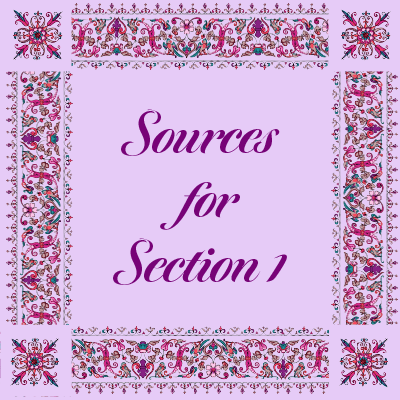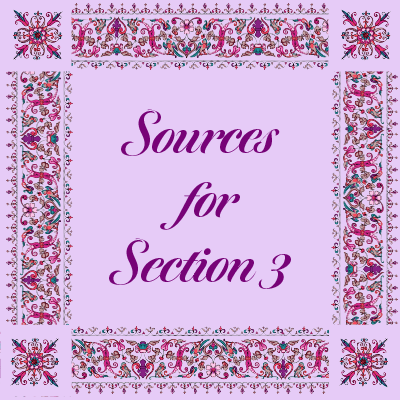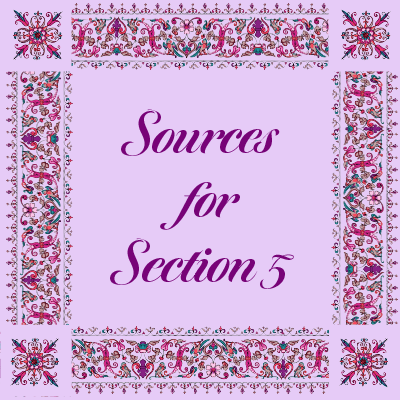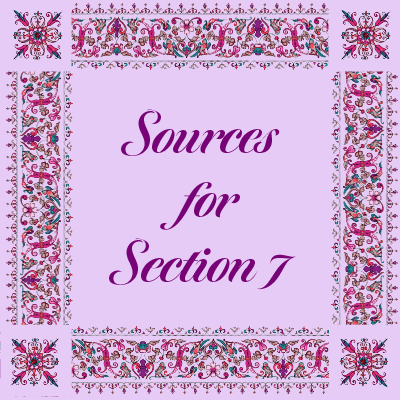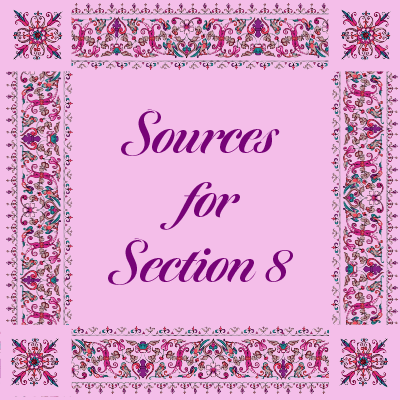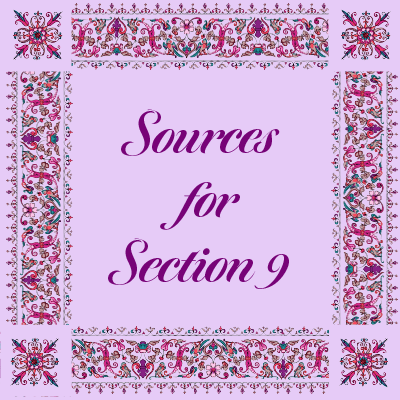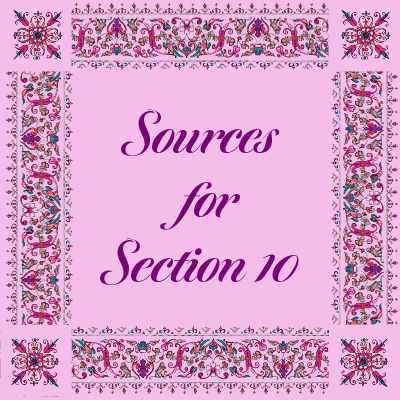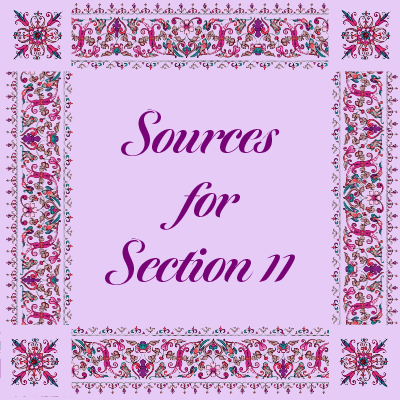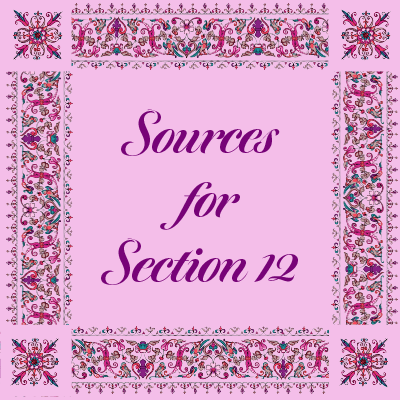
Written and illustrated by Violetta Zein
This part covers the life of the Greatest Holy Leaf from the age of 60 in 1906 to the age of 67 in 1913.
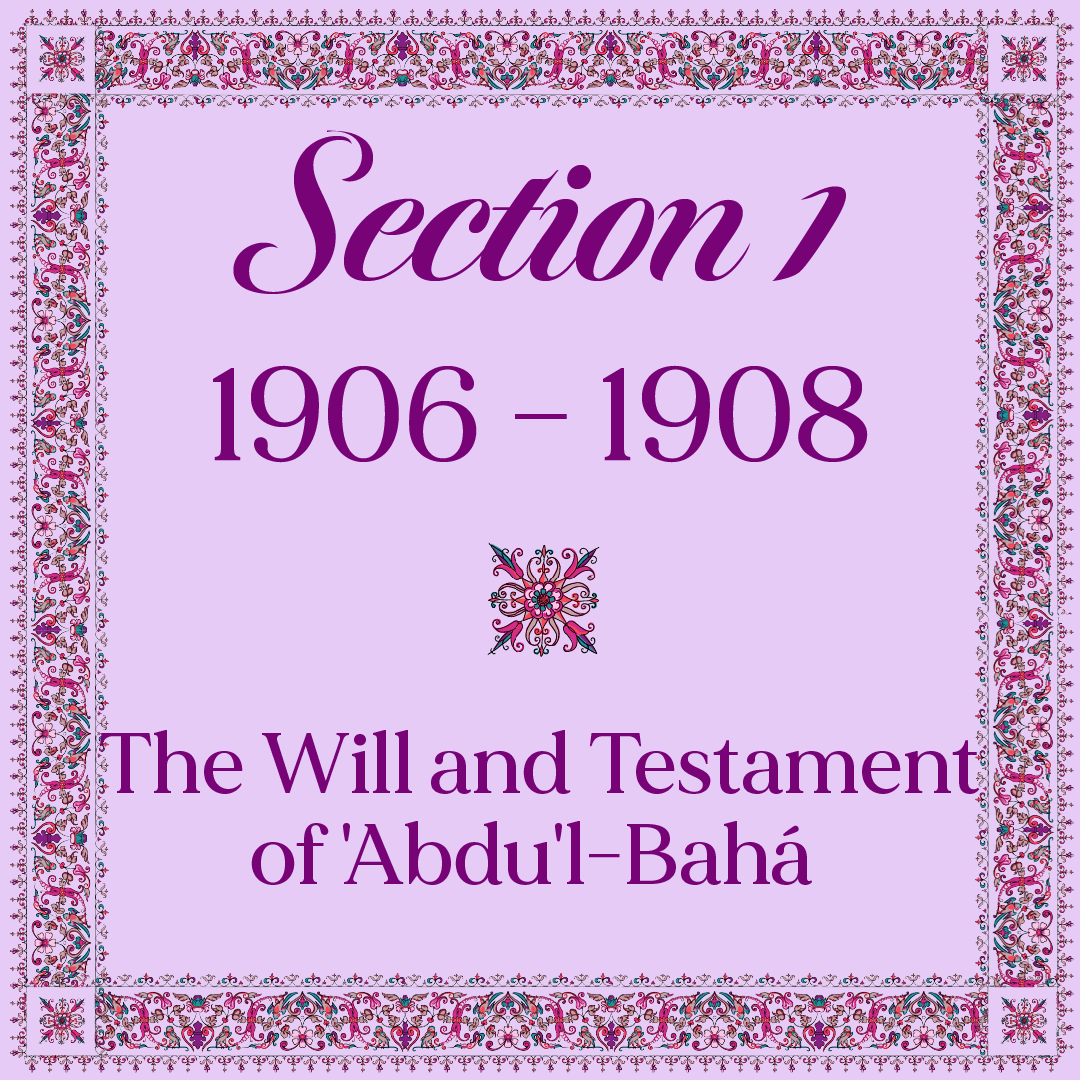

The inner courtyard of the courtyard of the House of 'Abdu'lláh Pashá. Source: Bahá'í Media Bank, © Bahá'í International Community 2024.
To pilgrims visiting 'Abdu'l-Bahá and the Holy Family during these tense years, they never would have realized they were visiting an Ottoman prison, had it not been for the towering barracks of the citadel in 'Akká.
One female Bahá'í pilgrim was deeply impressed with the way in which Bahíyyih Khánum and the women of the Holy Family surmounted the difficulties they were facing.
Instead of their daily life being overshadowed by anxiety or sadness—which would have been completely understandable—life in the house of 'Abbúd was quite the opposite!
Of course, the running of the household of the Holy Family was depended on conditions of their imprisonment, and so life was not predictable in a real sense of the word, but that didn’t mean it affected the spirit of the members of 'Abdu'l-Bahá’s family. Quite the opposite in fact! They were calm and serene, and unaffected by difficulties or crises, unbowed and unbroken.
The members of the Holy Family went about their daily tasks, rendering their beautiful services, carrying on, moving forward with deep patience, never complaining, filled with radiant acquiescence and a calm acceptance of God’s will and wisdom, no matter what happened.
This did not mean the members of the Holy Family were oblivious to the danger that surrounded them at every moment. Far from it.
From the youngest to the oldest, from servants of the household to the Greatest Holy Leaf, they were watchful, alert, and aware of everything around them at all times, be it the creak of a distant door, unfamiliar footsteps. This was not anxiety, it was awareness.
At times during this pilgrim’s visit, the dinner table would have to suddenly be moved into another room to escape the notice of an unexpected Ottoman official’s arrival in the house of 'Abbúd. This would be done with a quiet smile, and no indication that it was inconvenient in the least.
Never did the members of the Holy Family make the pilgrims feel they were under constant strain, unending pressure, and lived in a permanently precarious position.
Never did the pilgrims feel they were being hosted by prisoners. But really, 'Abdu'l-Bahá and the Holy Family existed in a sort of living martyrdom, assailed on all sides by dangers which were, at times mortal.
In fact, 'Abdu'l-Bahá’s family delighted the pilgrims with their joyful, charming, spontaneous sense of humor. They found ways to laugh about even the smallest thing, extracting as much joy from it as they could, and encouraging each other to see the bright side of everything, always distracting their minds from their difficult and tragic living conditions.
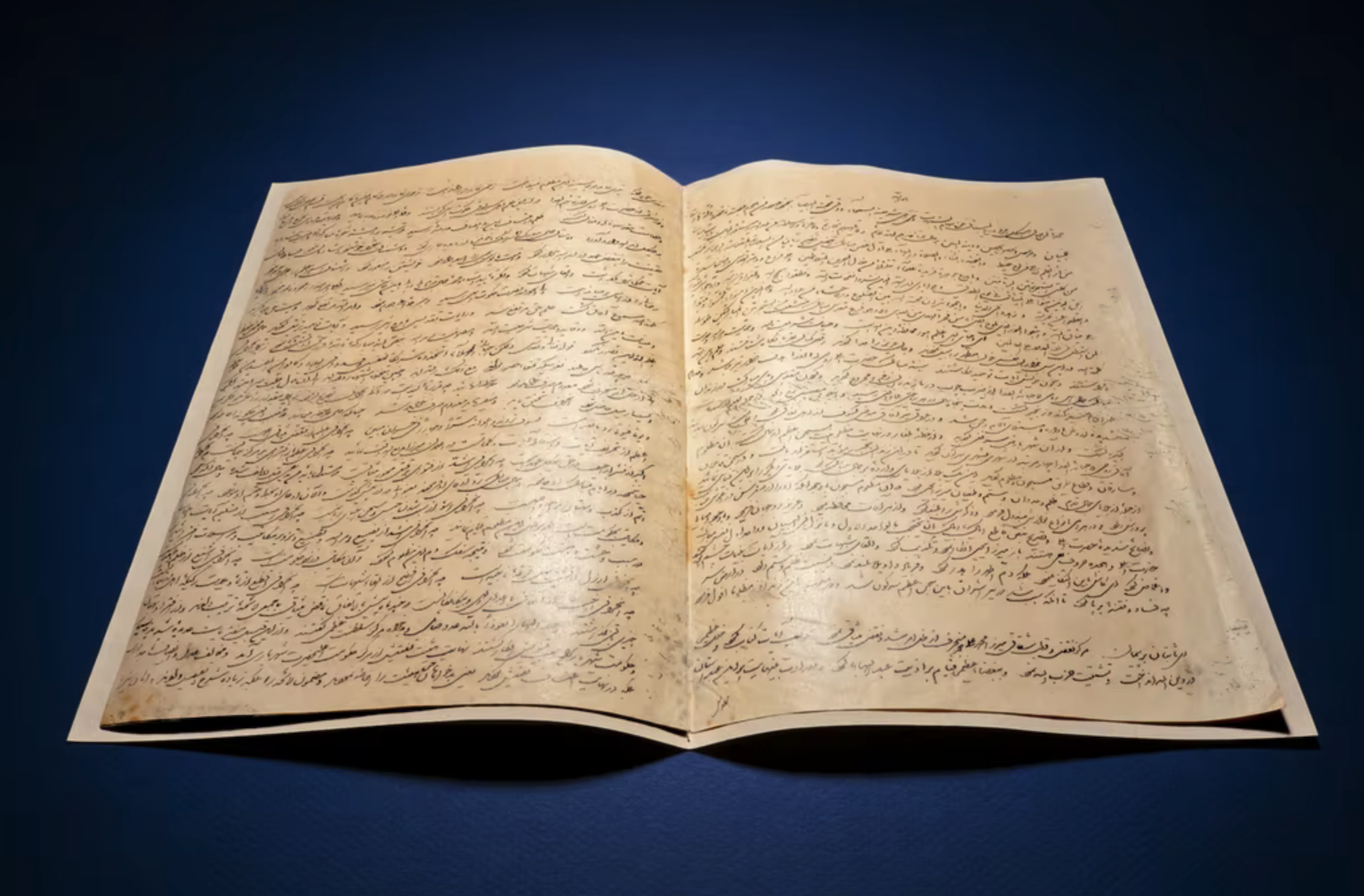
Photograph of the opening pages of the Will and Testament of 'Abdu'l-Bahá. Source: Bahá'í World News Service, 24 December 2021.
During this time of great danger, in 1906 and in 1908, when 'Abdu'l-Bahá was surrounded by the Covenant-breakers’ plots, enemies, Ottoman commissions of inquiry, threats against His life, and assassination attempts, He did not think He would live.
And so, 'Abdu'l-Bahá revealed His Will and Testament in three parts between the years 1906 and 1908.
In His Will and Testament of 'Abdu'l-Bahá named Shoghi Effendi—then a boy of 9 to 11 years old—as His legitimate and only successor, the future Guardian of the Cause of Bahá'u'lláh.
By revealing His Will and Testament, that preeminently important document, and one of the Charters of Bahá'u'lláh Administrative Order, 'Abdu'l-Bahá made provisions for the future world institutions of the Bahá'í Faith, such as the Universal House of Justice and the institution of Ḥuqúqu’lláh, as well as the institution of the Hands of the Cause, set forth by Bahá'u'lláh in the Kitáb-i-Aqdas.
Once His Will and Testament of 'Abdu'l-Bahá was revealed, 'Abdu'l-Bahá sealed it and buried it underground.
The only person He spoke to about it and about its provisions regarding Shoghi Effendi was the only person in the world He could trust, His sister, the Greatest Holy Leaf.
After 'Abdu'l-Bahá concealing the casket containing the remains of the Báb for a year in the Greatest Holy Leaf’s room, this is perhaps the second most profound sign of the implicit, unquestioned trust the Center of the Covenant placed on the Greatest Holy Leaf.
The confidence 'Abdu'l-Bahá put in Bahíyyih Khánum also speaks to her ability to manage delicate and confidential duties.


The Greatest Holy Leaf in Haifa. Photograph taken as part of a series of portraits in November 1900. © United States National Bahá'í Archives, used with permission.
The Greatest Holy Leaf brought a sense of order, organization, and unity as head of the household of the Holy Family, which she wielded to create a sense of both order and grace in the Holy household. All of the Greatest Holy Leaf’s leadership combined to create a sense of harmony and well-being in the house of the Master.
The household of the Holy Family in those days numbered over 100 people, not including the children. It was a huge family and a formidable responsibility.
Bahíyyih Khánum oversaw the purchase of ingredients and the meal preparation, and assigned each one of her four nieces the job of supervising the cooking for a week at a time.
The work involved was overwhelming and it was performed under difficult conditions.
There was no water, so it had to be drawn from a well, there was no gas or electricity or light, and all cooking was done with charcoal.
Despite their working conditions, kitchen in the house of the Master was spotlessly clean.
Bahíyyih Khánum was also directly involved with food preparation. Ella Goodall once saw the Greatest Holy Leaf in the kitchen, seated on a low stool, busy cutting a large piece of lamb, with huge pans holding soaking rice for Persian pilaf.
The food they made was served to different groups twice a day.
Under Bahíyyih Khánum’s masterful guidance, the household ran smoothly, and every emergency was addressed with calm and composure. All the women in the household of the Holy Family understood her unique spiritual station.
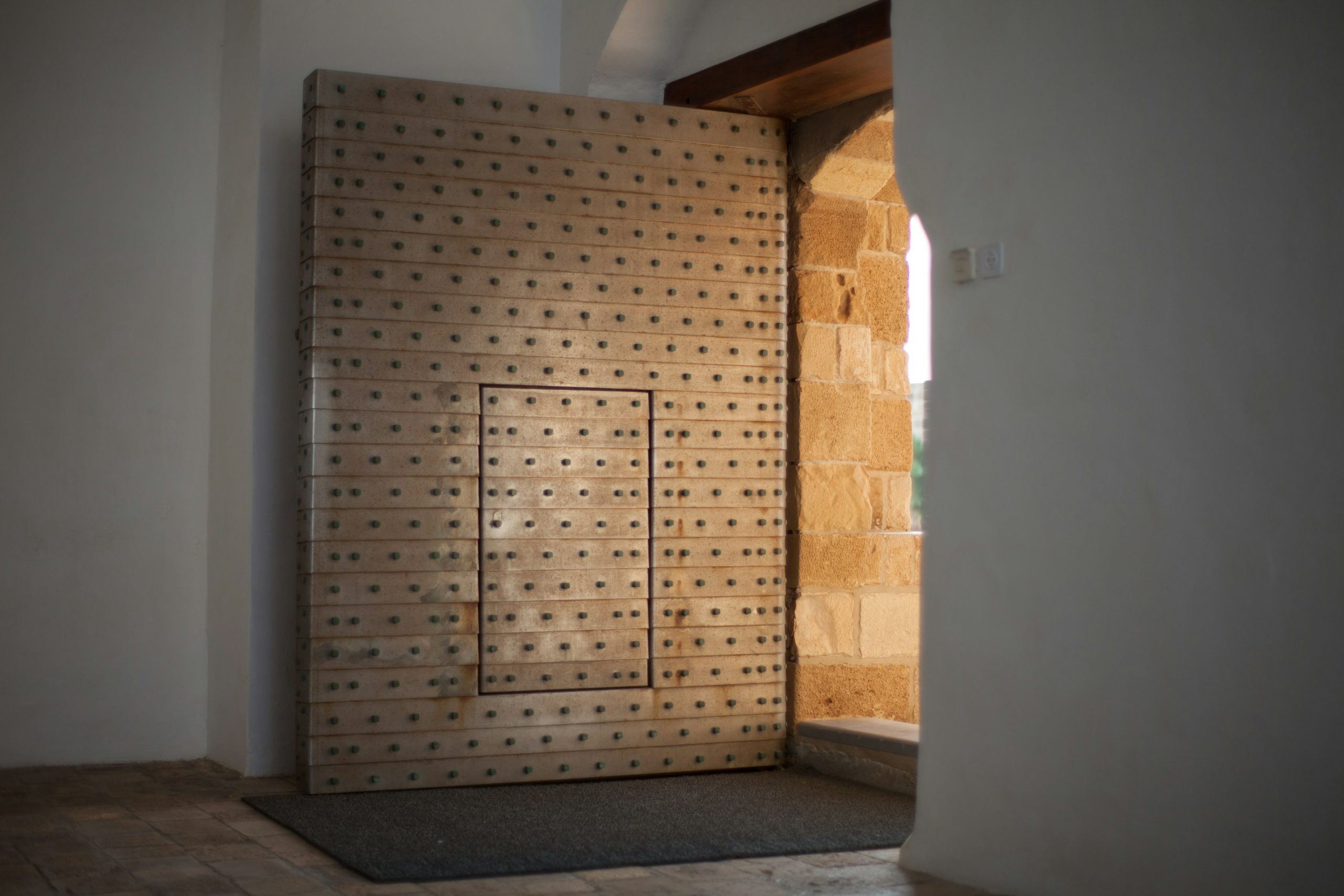
Door to the House of 'Abdu'lláh Pashá. Source: Bahá'í Media Bank, © Bahá'í International Community 2024.
Bahíyyih Khánum was responsible for coordinating the activities of all Bahá’í women, both local residents and visiting pilgrims, and the center of these activities was a room in the house of the Master called the Ladies’ Room.
Bahíyyih Khánum—who was always referred to simply as “Khánum” or “Lady”—was always in demand in the Ladies’ Room. The activities in the Ladies’ Room went from early morning tea at 6:00 AM—which 'Abdu'l-Bahá often attended—to 11:00 PM or midnight, and the spiritual atmosphere in the room was a completely new and unbelievable experience for the western pilgrims.
Bahíyyih Khánum met with the wives of both pilgrims and officials, she cared for all women who passed through the door of the house of the Master.
The Greatest Holy Leaf would honor a Persian woman by asking her to chant a Tablet, then she would share news of the progress of the Faith, 'Abdu'l-Bahá’s latest talks and utterances, and the women sipped tea while the samovar bubbled gently.
The entire community of local women Bahá'ís in the Holy Land gravitated around the Greatest Holy Leaf.
Western pilgrim women were attracted to the Ladies’ Room as by a magnet.
There were also weekly events in the Ladies’ Room.
On Wednesday afternoons, a “Women’s Meeting” was held for women only. One of 'Abdu'l-Bahá’s daughters would read or chant prayers or Tablets, and tea was served with Persian cookies and grapes. 'Abdu'l-Bahá sometimes made an appearance if He had the time.
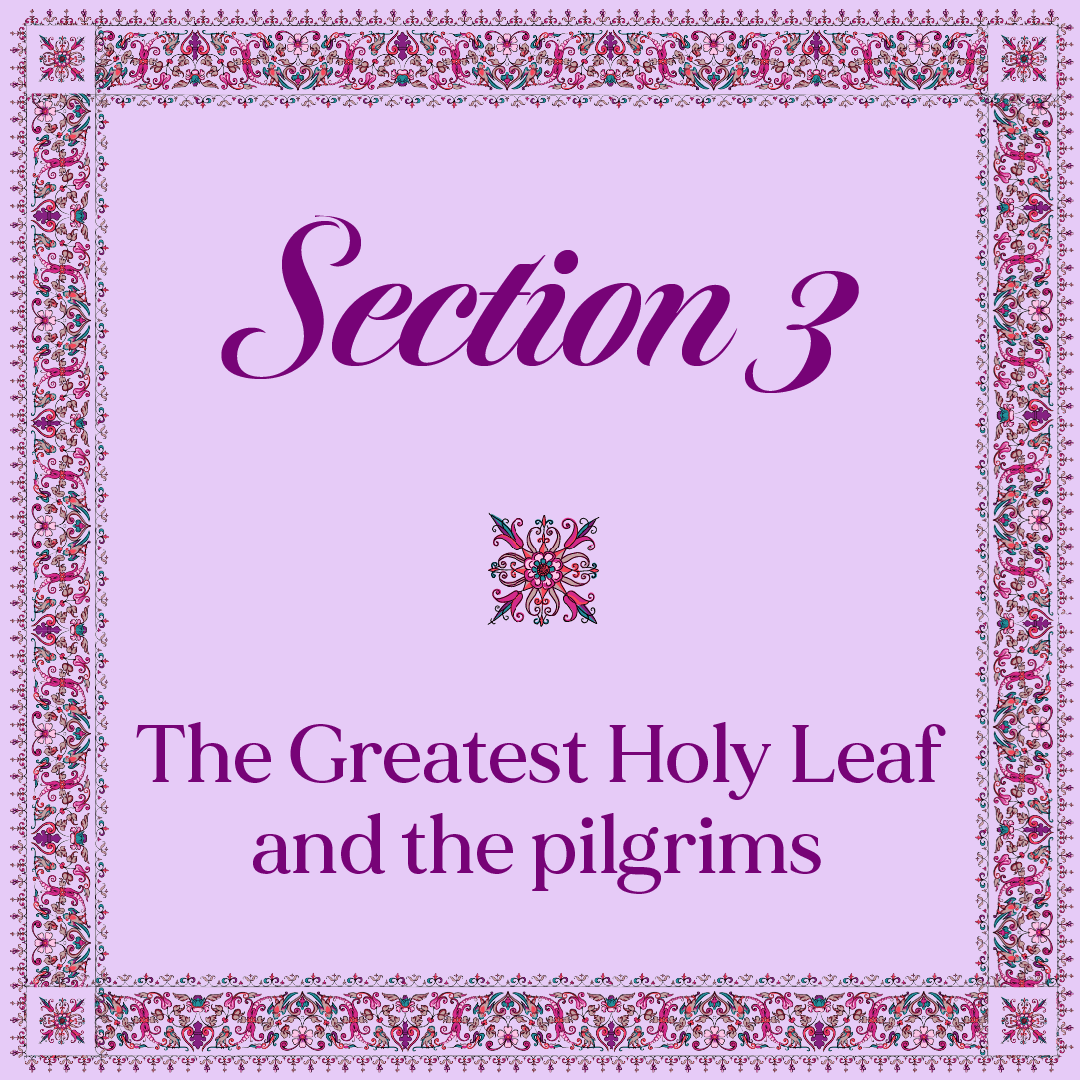
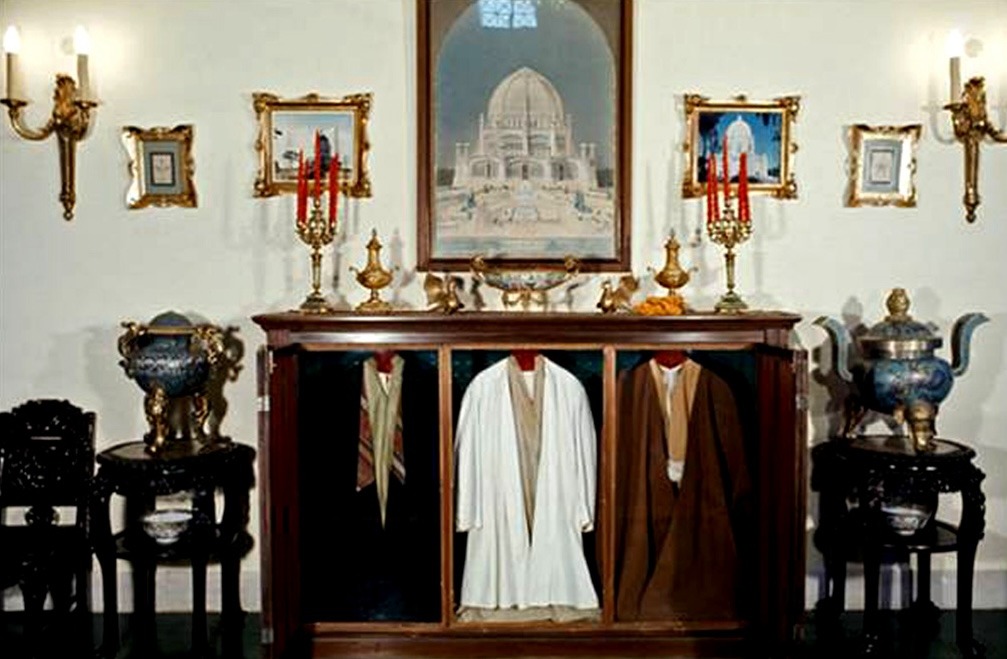
Three of the robes worn by Bahá’u’lláh displayed in the Bahá'í International Archives. Source: Bahá'í Sacred Relics.
One of the Greatest Holy Leaf’s most unique and important responsibilities was as custodian of the holy relics of the Faith.
She ensured the preservation and protection of the Holy Writings of Bahá'u'lláh and the Báb, as well as their sacred portraits. She also made sure that relics and objects from the Heroic Age of the Faith were collected, and looked after their proper storage.
It was Bahíyyih Khánum who unveiled these relics to female pilgrims, escorting them to a room in the house of the Master where they were kept in order to allow them to view the portraits of Bahá'u'lláh and the Báb.
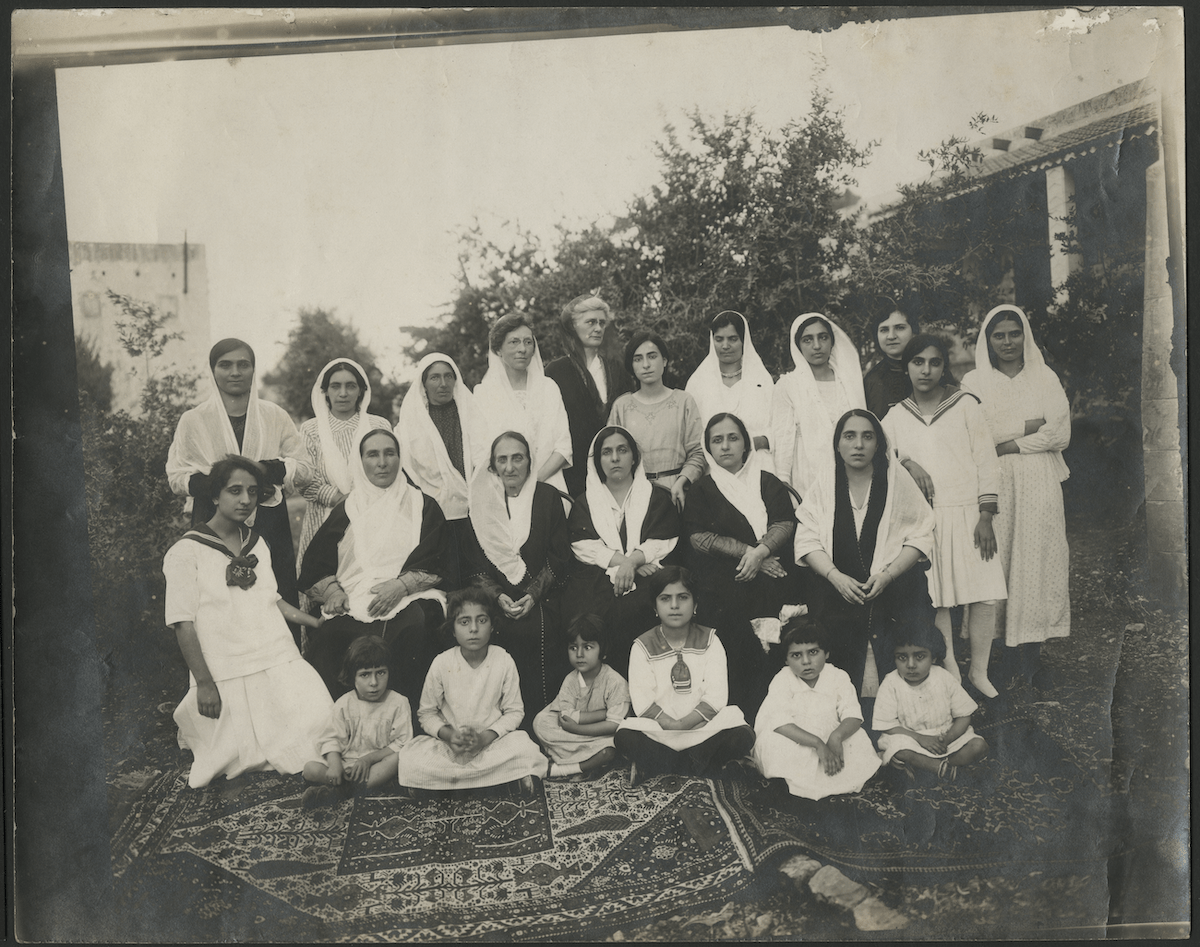
Group photograph taken in Haifa in 1920 with the Greatest Holy Leaf and two western women pilgrims. This photograph was taken as part of a series of photographs in the same setting with different people, but always with the ladies of the Holy Family seated in the center. A handwritten caption on the back of one of the photographs of the series reads:
“Photograph taken behind the houses of 'Abdu'l-Bahá and Rúhá Khánum in Haifa, Palestine in 1920. We understand this was the first time the ladies of 'Abdu'l-Bahá’s family had had their photographs taken or appeared unveiled and we were asked not to circulate the pictures. [caption is not signed.”
Seated, in the middle row are the women of the Holy Family. From left to right: The Greatest Holy Leaf, Munírih Khánum, Ḍíyá‘íyyih Khánum—the mother of Shoghi Effendi—Túbá Khánum, and Rúhá Khánum, three of the four daughters of 'Abdu'l-Bahá and Munírih Khánum.
Standing in the back row are the women of the Holy Family. The western woman standing directly above the Greatest Holy Leaf is Julia Culver, and next to her, dressed in black is Emogene Hoagg.
In the front row are the grandchildren of 'Abdu'l-Bahá and Munírih Khánum, the children of their daughters
© United States National Bahá'í Archives, used with permission.
The Greatest Holy Leaf’s meetings with the women pilgrim were not only a major part of her role in the Faith, but they also served an important purpose.
Women, in pilgrim note after pilgrim note emphasize the transformative effect of being in the same room as Bahíyyih Khánum, of listening to her talk, of watching her actions.
The power of Bahíyyih Khánum was a quiet one, but a power that penetrated deep in the women’s souls.
To pilgrims, Bahíyyih Khánum would recount her vivid memories of life in the Heroic Age, during the early days of the Faith. These precious recollections had a deep impact. Hearing about important. events from Bahá'í history from someone who had been both a witness and taken active part in them, inspired the pilgrims’ collective imagination.
Through moments like these, pilgrims gained a clear understanding of Bahíyyih Khánum’s high spiritual station in the Faith.
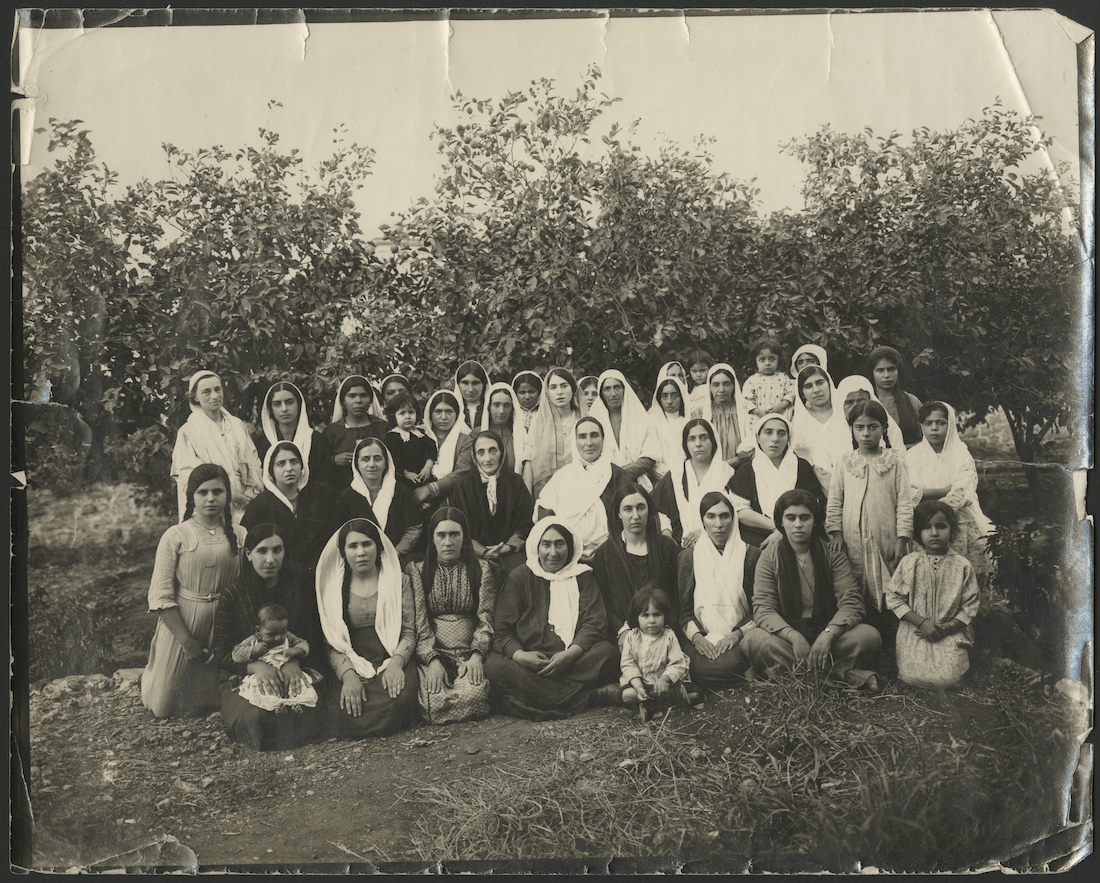
A photograph dated February 1920 of the women of the Holy Family, all seated in the middle row, on chairs, surrounded by pilgrims, resident believers and children. © United States National Bahá'í Archives, used with permission.
From left to right, seated in the middle row:
❈ Munavvar Khánum (‘Abdu'l-Bahá and Munírih Khánum’s fourth daughter);
❈ Ṭúbá Khánum (‘Abdu'l-Bahá and Munírih Khánum’s second daughter);
❈ Bahíyyih Khánum, the Greatest Holy Leaf and Sister of 'Abdu'l-Bahá;
❈ Munírih Khánum, wife of 'Abdu'l-Bahá;
❈ Ḍíyá‘íyyih Khánum (‘Abdu'l-Bahá and Khánum’s first daughter and the mother of Shoghi Effendi);
❈ Rúḥá Khánum, (‘Abdu'l-Bahá and Khánum’s third daughter).
Bahíyyih Khánum’s life was also a source of inspiration. Pilgrims saw her radiant acquiescence in times of difficulty and how she bore everything that came her way with infinite patience.
But the pilgrims also realized that the Greatest Holy Leaf had consciously shaped her life into the sphere she was permitted to function in, given the cultural restrictions of the time, and that she had poured her entire spiritual resources and showed forth all her qualities in that sphere.
The Greatest Holy Leaf loved having contact with the women pilgrims. She was so passionate about the spread of her Father’s Faith in the far-flung corners of the earth that she found great joy in receiving and sharing news of the Faith’s growth with pilgrims and visitors.
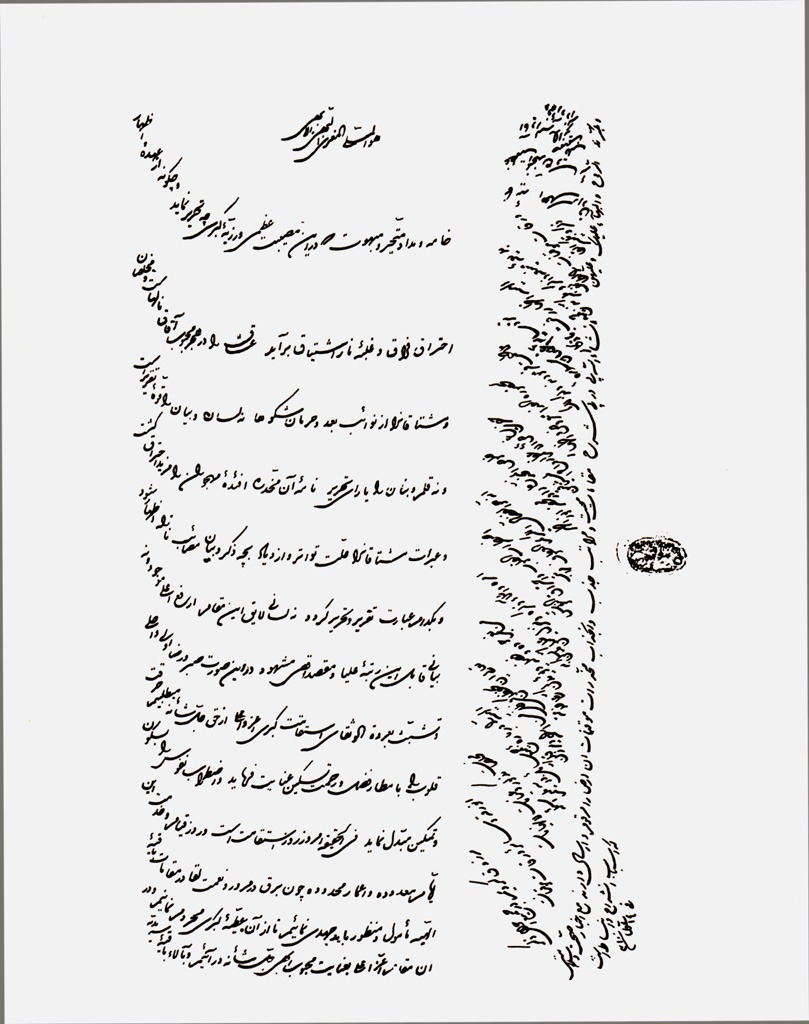
Facsimile of the handwriting of the Greatest Holy Leaf. Source: Bahá'í Sacred Relics.
Bahíyyih Khánum also wrote letters to certain pilgrims after they returned home. To an eastern pilgrim, wrote about the significance of her pilgrimage and encourages her to teach:
Praised be God that after attaining the holy Threshold of the Merciful in this hallowed land, this luminous Spot, you were able to take back with you the gift of the divine fragrance of holiness, to perfume the nostrils of the handmaids of God, to refresh and stimulate, nay rather revive and quicken the lifeless bodies through the potency of His wondrous exhortations, His sublime counsels and teachings.
And to a western woman who had come when the Greatest Holy Leaf was absent from Haifa, she kindly writes to comfort her, asking her not to be discouraged, but rather to go out into the world and teach, encouraging her with kind words:
We soon will hear of your wonderful services in the Path of the Cause of God…Be sure you will be successful at the end, for He has sent you and He will surely be with you and help you always.

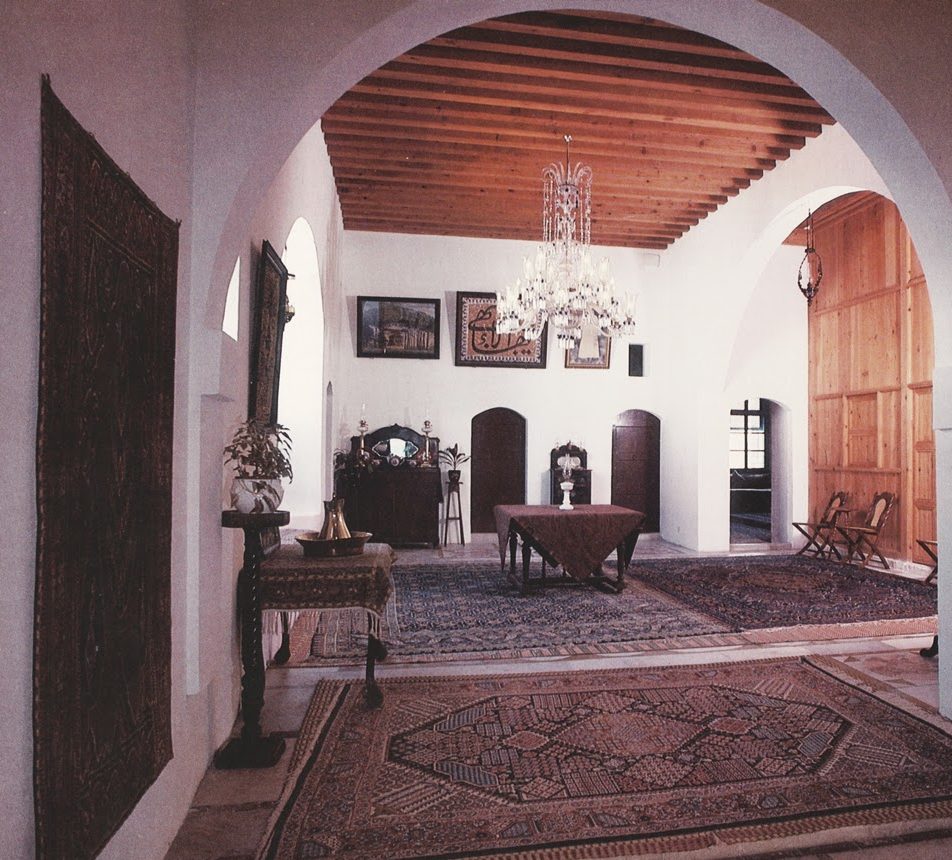
Main hall in the House of 'Abdu'lláh Pashá in 'Akká. Source: Bahá'í Points of Interest.
There was a member of 'Abdu'l-Bahá’s household, A.M. Qulí, whose function it was to tell 'Abdu'l-Bahá the time. Every day at around 11 in the morning, 'Abdu'l-Bahá would enter the great hall of the house and ask A.M. Qulí:
Qulí, sá‘at chandih? [What time is it?]
Then, the maids would set up for lunch. After laying down a large cloth on the floor of the old tea room, they placed a huge low-legged round table on it and set enamel metal plates down, along with spoons and bread.
‘Abdu'l-Bahá would sit down and call out to His family:
Bíyá bishíníd! [Come and sit down!]
The seat next to 'Abdu'l-Bahá was always reserved for Bahíyyih Khánum, the Greatest Holy Leaf, and she would enter about half way through lunch, and bring a plate of food. Gradually, as 'Abdu'l-Bahá finished eating, others would enter, women, guests or children, His daughters.
The second lunch was much noisier than 'Abdu'l-Bahá’s dignified, calm lunch.
The children would cry and everyone would talk. But one thing all the grandchildren were watching out for was the mouthful of the Greatest Holy Leaf’s food which she would give to one or the others of her great-nephews or nieces, because the children all said that her food tasted the best and they called it “the mouthful of Khánum.”
Shoghi Effendi was usually the one who got to eat it, because of course, he was her favorite.
Once the ladies and children of the household had eaten, it was the servants’ turn, at the same table, then lunch would be cleared, and everything, including the large round table, rolled back and put away in its place.
Once 'Abdu'l-Bahá returned from His Journeys to the West, more western ways of eating were introduced like ceramic plates, chairs, and cutlery.

Shoghi Effendi during his school years, holding a small bouquet. Source: The Priceless Pearl, between pages 24 and 25.
Shoghi Effendi had grown up worshipping 'Abdu'l-Bahá and the Greatest Holy Leaf, they were his two most beloved people in the world.
Both the Master and Bahíyyih Khánum also adored him, and even if they tried not to show it, Shoghi Effendi was their favorite grandchild/grand-nephew.
Shoghi Effendi was a constant reminder to the Greatest Holy Leaf of her beloved father, Bahá'u'lláh. When he was a child, the Greatest Holy Leaf would take Shoghi Effendi’s hands in hers and say:
These are like the hands of my father.
It is clear that Shoghi Effendi was much closer to 'Abdu'l-Bahá and the Greatest Holy Leaf than his parents, aunts, and siblings. Shoghi Effendi always considered the Greatest Holy Leaf to be an incarnation of 'Abdu'l-Bahá's all-encompassing tenderness and love.
This is how Rúḥíyyih Khánum describes the love between Shoghi Effendi and his Great-Aunt:
However faithful and tender Shoghi Effendi’s relationships were throughout his life with those closest to him, his supreme relationship was with the Greatest Holy Leaf.
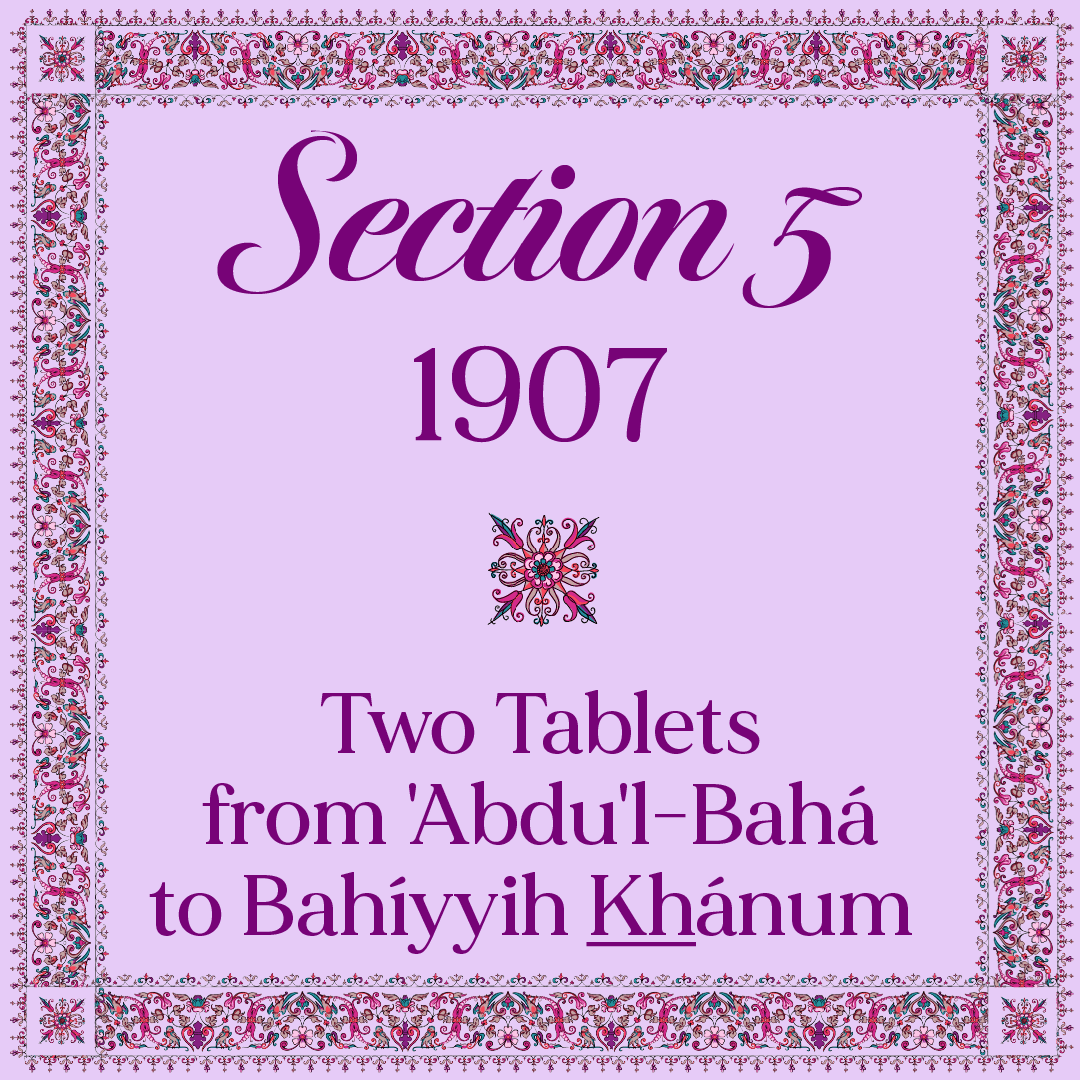

Shoghi Effendi as a young child. Baha'i Media.
It is interesting to note that Bahíyyih Khánum traveled around the Holy Land.
We have several records of Tablets of 'Abdu'l-Bahá written to Bahíyyih Khánum when she was traveling to Haifa, and Shoghi Effendi is mentioned at the end of two of these Tablets around 1907, indicating that he was either living in Haifa and attending school there or that he had accompanied his great-aunt on her visits to Haifa.
The first letter from 'Abdu'l-Bahá mentions the climate of Haifa:
O My sister in the spirit, and the companion of my heart!
God willing, the climate of Haifa hath proved favourable. I hope that out of the bounties of the Ancient Beauty thou wilt gain a measure of peace and health. I bring thee to mind both night and day. Just recently I had hoped to come to Haifa to visit thee, but various problems and the pressure of work have left me no time; for I want to see the travelers off, and every one of them presented a long list of names. God be thanked, I have written to the them all. Kiss the fresh flower of the garden of sweetness, Shoghi Effendi.
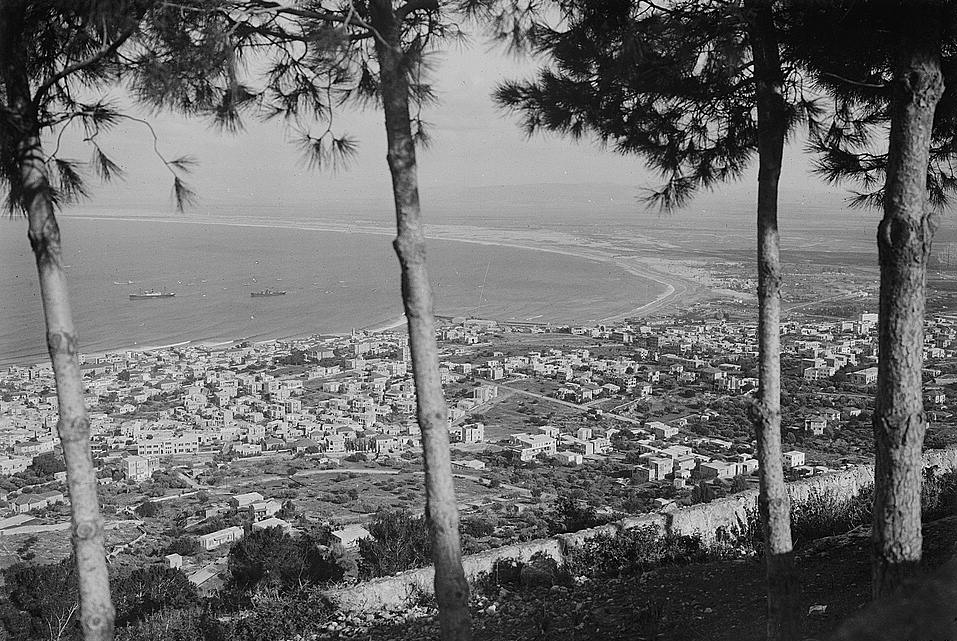
Haifa and Zvulun Valley between 1920 and 1933. Source: Wikimedia Commons.
'Abdu'l-Bahá’s second Tablet—this one undated—mentions that Bahíyyih Khánum’s visit to Haifa was short:
O My spiritual sister!
Thou didst go away to Haifa, supposedly for only three or four days. Now it becometh apparent that the spiritual power of the Shrine hath brought thee joy and radiance, and even as a magnet is holding thee fast. Thou surely wouldst remember us as well.
Truly the spiritual quality of the holy place, its fresh skies and delicate air, its crystal waters and sweet plains and charming seascape, and the holy breathings from the Kingdom all do mingle in that Sacred Fold. Thou art right to linger there…
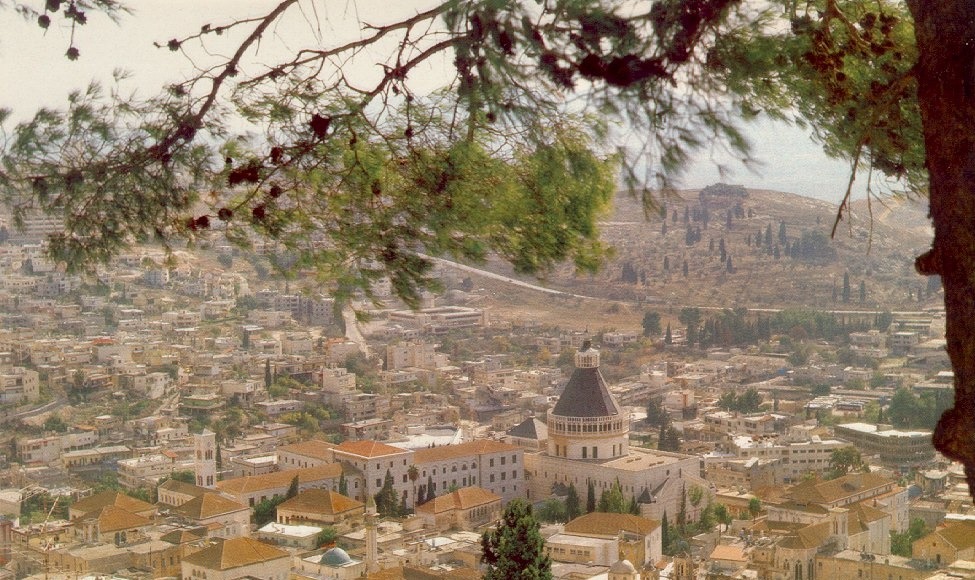
A modern view of Nazareth. Source: Wikimedia Commons.
Bahíyyih Khánum also traveled to Nazareth—though we do not know which year—as indicated in a Tablet 'Abdu'l-Bahá revealed for the Greatest Holy Leaf when she was in Nazareth:
O My dear sister!
It is quite a while now, since thou hast left us, and gone away to Nazareth and Haifa. This journey hath lasted too long. The weather in 'Akká is fine and moderate. If thou comest back, it will rejoice our hearts.
At the end of this Tablet, 'Abdu'l-Bahá asks Bahíyyih Khánum to convey His loving greetings to the parents of Shoghi Effendi—Ḍíyá‘íyyih Khánum and Mírzá Hádí Shírází—and to kiss for Him the spiritual Shoghi Effendi.
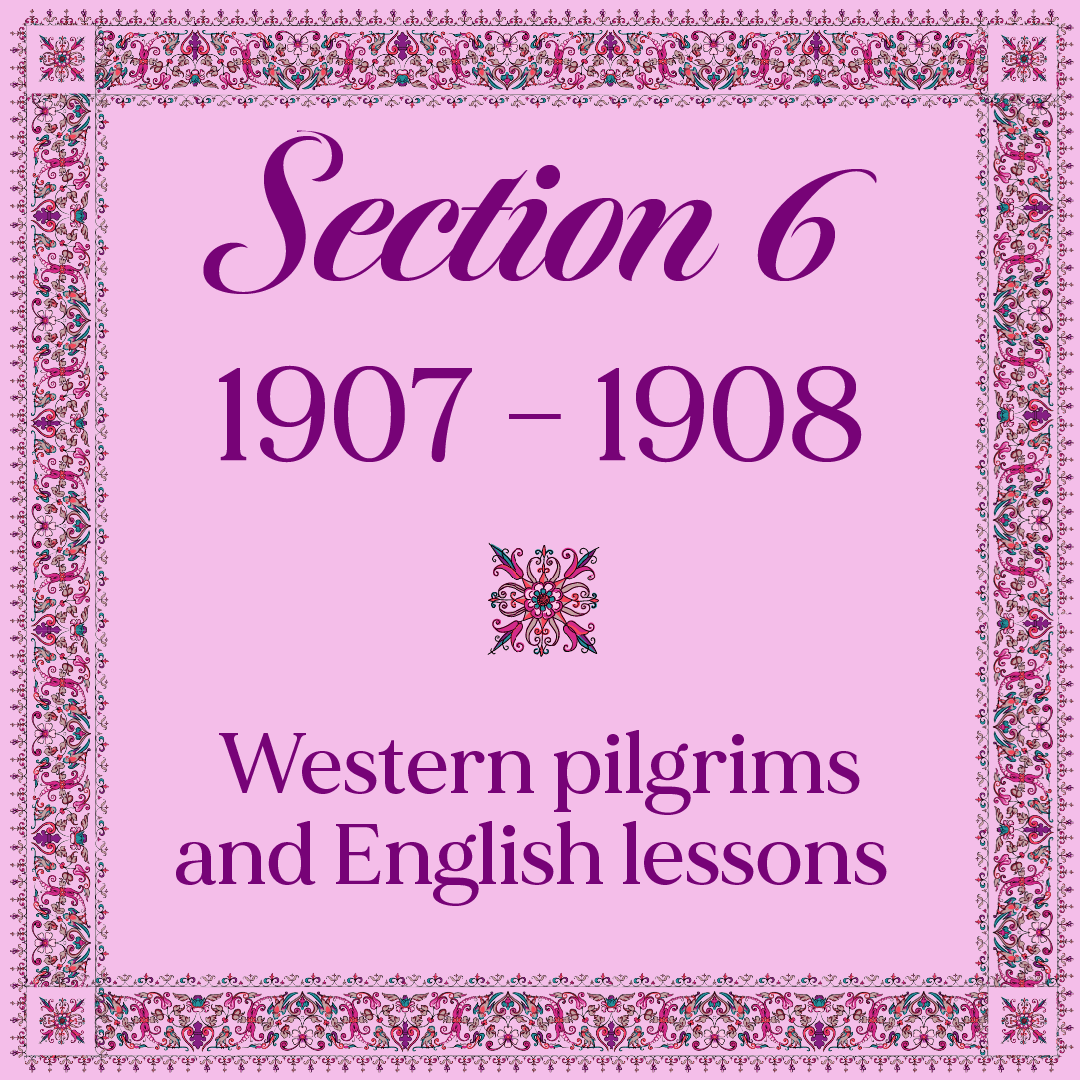
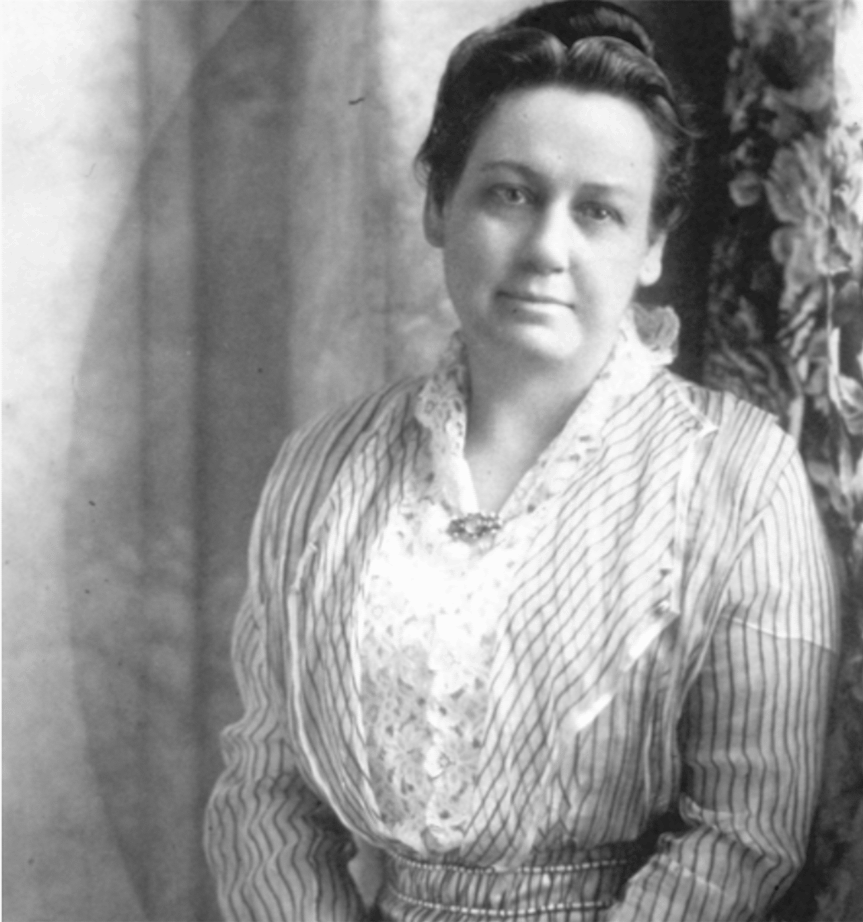
Corinne True. Source: The Journey West.
Corinne True and her 16-year old daughter Arna came on a six-day pilgrimage to 'Akká in 1907.
The Greatest Holy Leaf came to call on them in their room, and meeting and getting to know Bahíyyih Khánum would be an unforgettable experience for Corinne.
She would treasure the moments she spent with the daughter of Bahá'u'lláh for the rest of her life.
Corinne noticed that the Greatest Holy Leaf kept the same schedule as 'Abdu'l-Bahá: busy from dawn to midnight, every day. 'Abdu'l-Bahá managed the affairs of the Faith, and the Greatest Holy Leaf managed the affairs of the household of the Holy Family.
It was the Greatest Holy Leaf who saw that there was always enough food and tea, that there were enough supplies, and that the needs of the family were met. She was the one who took care of all the pilgrims and tended to their every need.
In the Greatest Holy Leaf, Corinne felt a quiet strength, wisdom and compassion.
Whenever 'Abdu'l-Bahá was away from 'Akká, everyone turned to the Greatest Holy Leaf.
She was not only profoundly deepened in the Writings of Bahá'u'lláh, she understood the reality of the Covenant, and she carried out her duties with devotion.
One day during her pilgrimage, Corinne asked Bahíyyih Khánum to recount some her experiences during Bahá'u'lláh’s ministry. Bahíyyih Khánum narrated for Corinne their exile from Persia, and their successive exiles until 'Akká.
Interestingly, two points on which Bahíyyih Khánum spoke about at length were the sufferings her mother, Ásíyih Khánum endured, as well as the 10-day ship journey from Gallipoli to 'Akká in 1868.
Very shortly after their visit, the Greatest Holy Leaf had a small bottle of attar of rose sent to Corinne and Arna as a parting gift.

Marion Jack. Source: Bahaipedia.
In 1907, Edith Sanderson had gone on pilgrimage to the Holy Land and returned with news that 'Abdu'l-Bahá was looking for an English teacher for his four daughters: Ḍíyá‘íyyih Khánum, Ṭúbá Khánum, Rúḥá Khánum and Munavvar Khánum.
Marion Jack arrived in ‘Akká sometime in January 1908, and would stay for the next six months in 'Akká, teaching English to the Holy Family.
During her time in 'Akká, Marion was in the room of the Greatest Holy Leaf and Shoghi Effendi, then 11, came into the room. He was home for the holidays from his Monastery school on Mount Carmel, and was describing to the Greatest Holy Leaf everything that had happened during his time away from her.
Marion described both the play Shoghi Effendi staged and the feast he held for the servants of the Holy Family:
As there was a dramatic element at the Monastery School so he felt there should be in the holy household, and he drew up a poster which was placed in the hall. I never saw the theatricals but I can imagine that they were stage-managed. Then he held a banquet or feast rather in the servant’s quarters for all the young people, and I am told it was beautifully arranged with little paper napkins and flowers at each place.
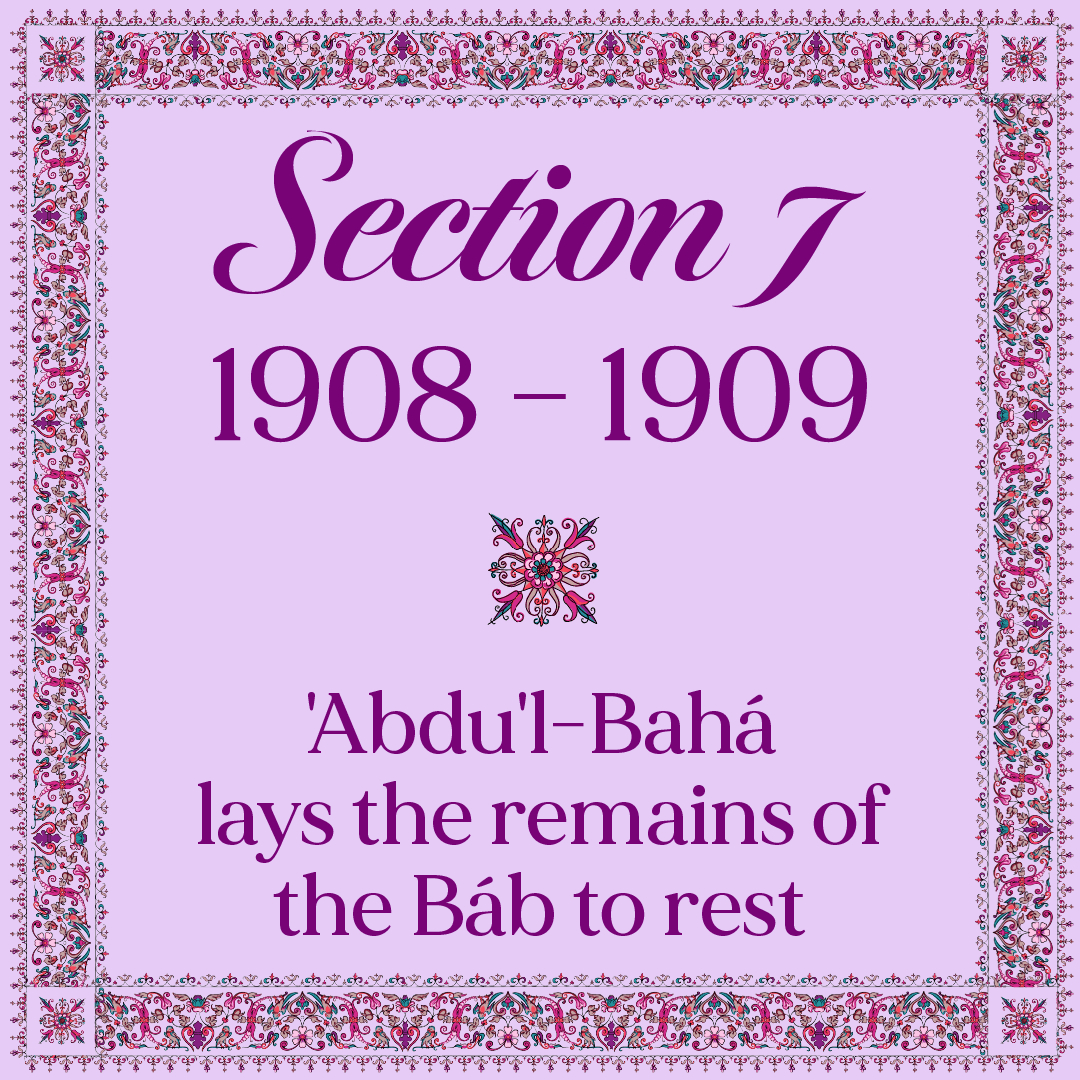
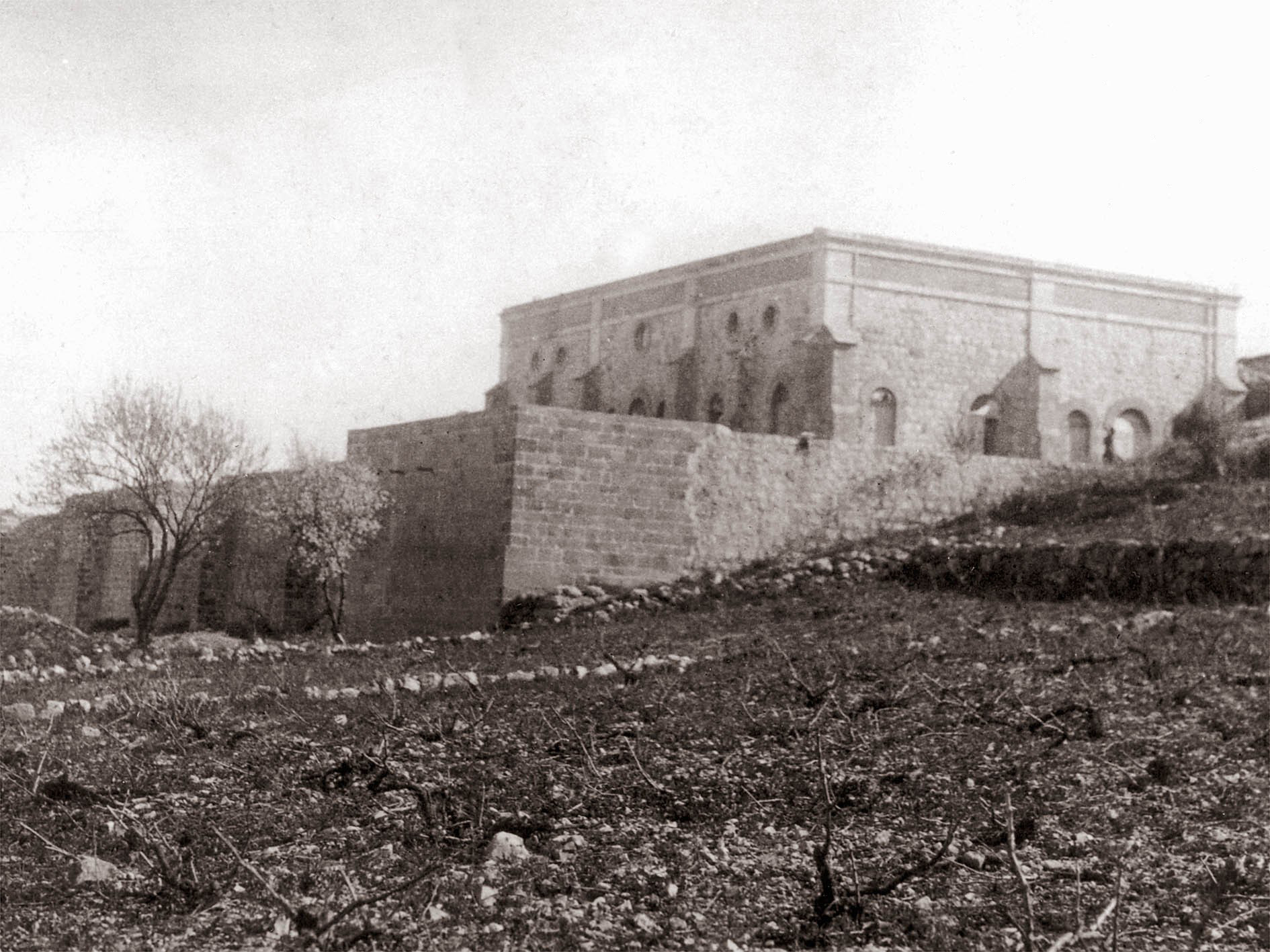
The Shrine of the Báb as it was on 21 March 1909 when 'Abdu'l-Bahá finally interred the remains of the Báb after 59 years of displacement. Source: Bahá'í World News Service.
The Young Turk Revolution forced Sulṭán ‘Abdu'l-Ḥamíd II to establish a constitutional government and release all political prisoners.
In August 1908, ‘Abdu’l-Bahá, Bahíyyih Khánum, and the rest of the Holy Family were finally free from imprisonment under the Ottoman Empire.
After 55 years of imprisonment and exile, 'Abdu'l-Bahá at the age of 64, and Bahíyyih Khánum at the age of 63, were both completely free for the first time since they were children.
They had spent their entire life as prisoners of the Ottoman Empire, and were now in their old age.
Finally, on 21 March 1909, 'Abdu'l-Bahá, at long last, laid the remains of the Báb to rest in His Shrine on Mount Carmel, in the exact spot Bahá'u'lláh had indicated to Him in 1891, 18 years before.
By the light of a single lamp, 'Abdu'l-Bahá removed His turban, His shoes, and His dark outer cloak. Bareheaded and barefoot, in simple white garments, 'Abdu'l-Bahá descended into the vault and placed the wooden casket containing the sacred remains of the Báb and His companion into the marble sarcophagus.
Then, 'Abdu'l-Bahá bent low over the casket and wept with such intensity that everyone present cried with Him. The ebony lid of the coffin was secured, and the marble lid of the sarcophagus closed forever. 'Abdu'l-Bahá chanted the prayer for the dead. Overcome with emotion, 'Abdu'l-Bahá could not sleep that night.

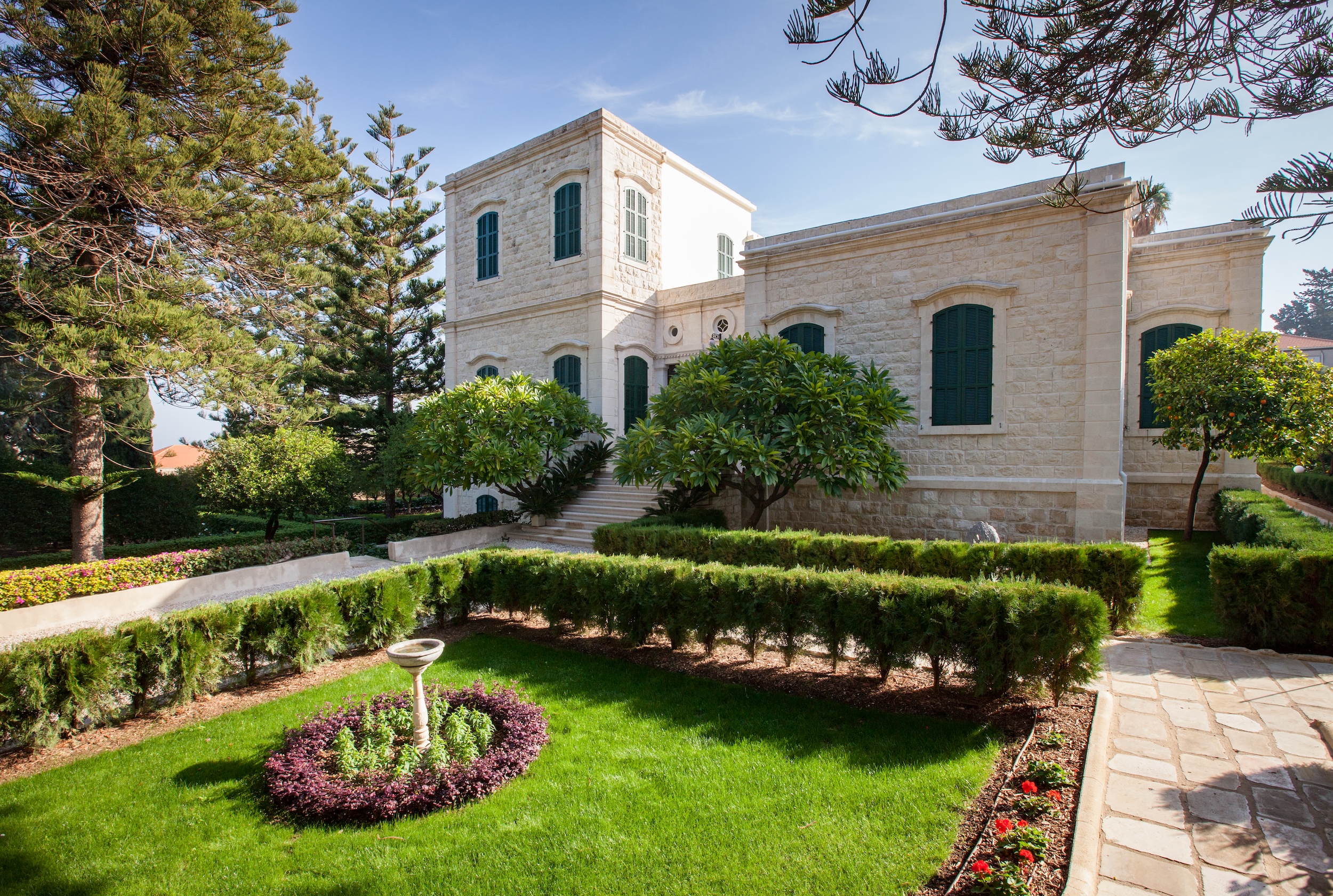
The House of the Master in Haifa at 7 Haparsim. Source: Bahá'í World News Service.
While the construction of the Shrine of the Báb on Mount Carmel was underway, 'Abdu'l-Bahá was also building a new house for Himself and His family in Haifa, at the foot of Mount Carmel.
By 1907, 'Abdu'l-Bahá’s new house, which would later be known as The Master’s House, was ready at 7 Haparsim, and some of 'Abdu'l-Bahá’s family began moving there in February 1907, if not earlier. 'Abdu'l-Bahá and the Greatest Holy Leaf’s move from 'Akká to Haifa did not happen at once, but by 1909—after the interment of the Báb’s remains in the Shrine on Mount Carmel—they were living in Haifa, having left 'Akká for good.
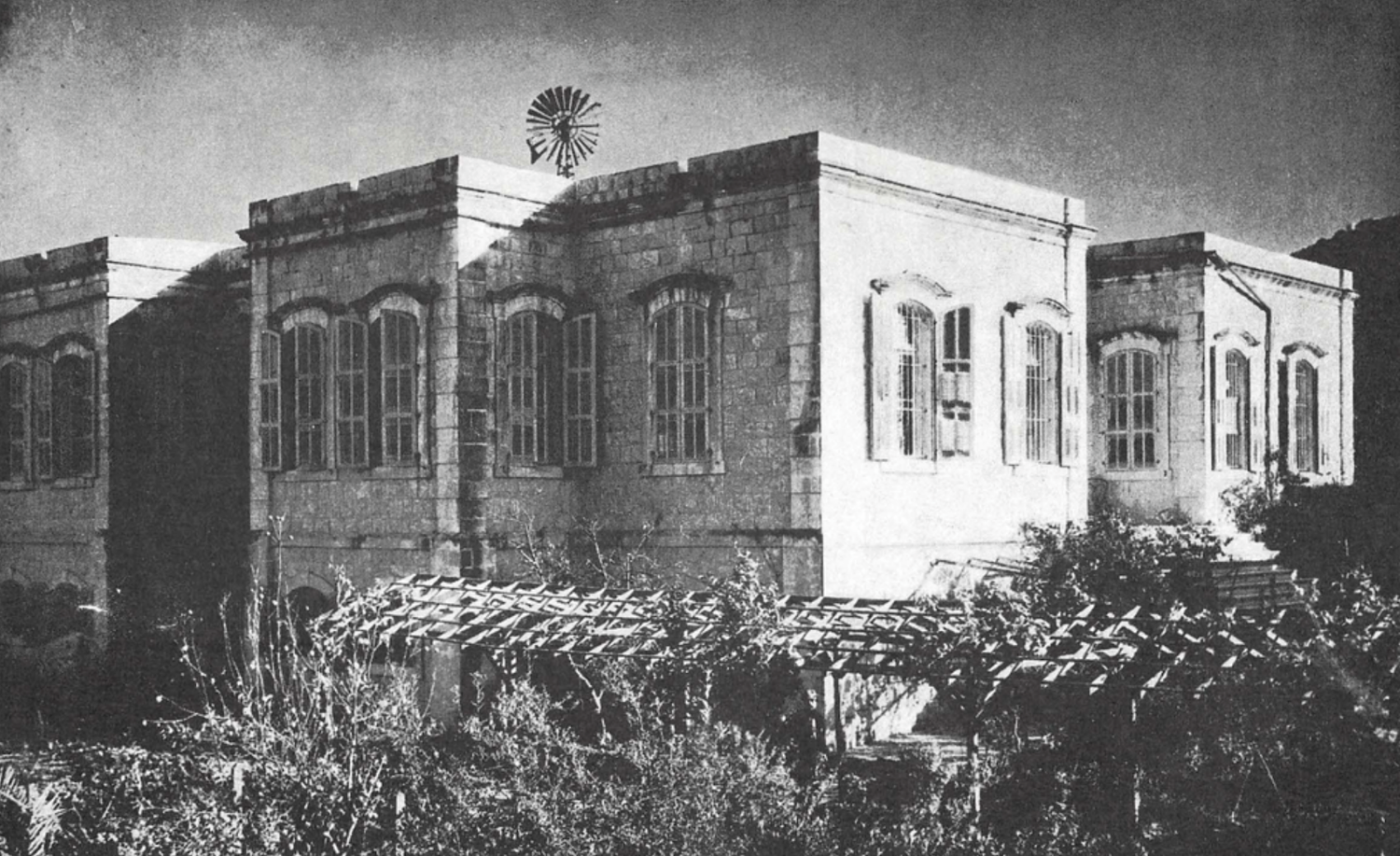
The House of the Master as it was during His lifetime. The Bahá'í World, volume 13 (April 1954-1963) page 69.
Dr. Ḥabíb Mu’ayyad was a recently-graduated doctor and devoted Bahá'í, who spent 8 years in the Holy Land at 'Abdu'l-Bahá’s request offering his medical services both before and during World War I from 1907 to 1915.
In his memoirs, Dr. Ḥabíb Mu’ayyad describes a social action initiative which the Greatest Holy Leaf began after her freedom in 1908.
Bahíyyih Khánum opened an unofficial orphanage in the house of the Master—and by unofficial, meaning she offered shelter to poor and homeless orphans.
Bahíyyih Khánum showered her love on the children, treating them all with the same sweet kindness, whether they were boys or girls, black or white, Arab, Christian, Jewish or Bahá'í.
The Greatest Holy Leaf took care of all the aspects of the children’s lives which they needed in order to live full and fulfilling lives. She cared for their spiritual lives, and instituted dawn prayers. The orphans learned to study the Holy Writings, and learned about spiritual virtues, qualities and human perfections.
She cared about their social interactions, teaching them courtesy and good manners, and how to behave and relate to others.
Bahíyyih Khánum also prepared them for a productive life in society and had literacy classes. But the orphans under the care of the Greatest Holy Leaf did not just learn to read and write, they also learned practical professional skills such as home management, embroidery, sewing, and cooking.
Dr. Ḥabíb Mu’ayyad, speaking of the Greatest Holy Leaf’s work with the orphans, made an astounding statement:
She adorned them with the ornament of knowledge, good character, perfection and fear of God. She turned them into fruitful trees, led them to the highway of guidance, prepared them for living the life, made them prosperous and delivered them to society…
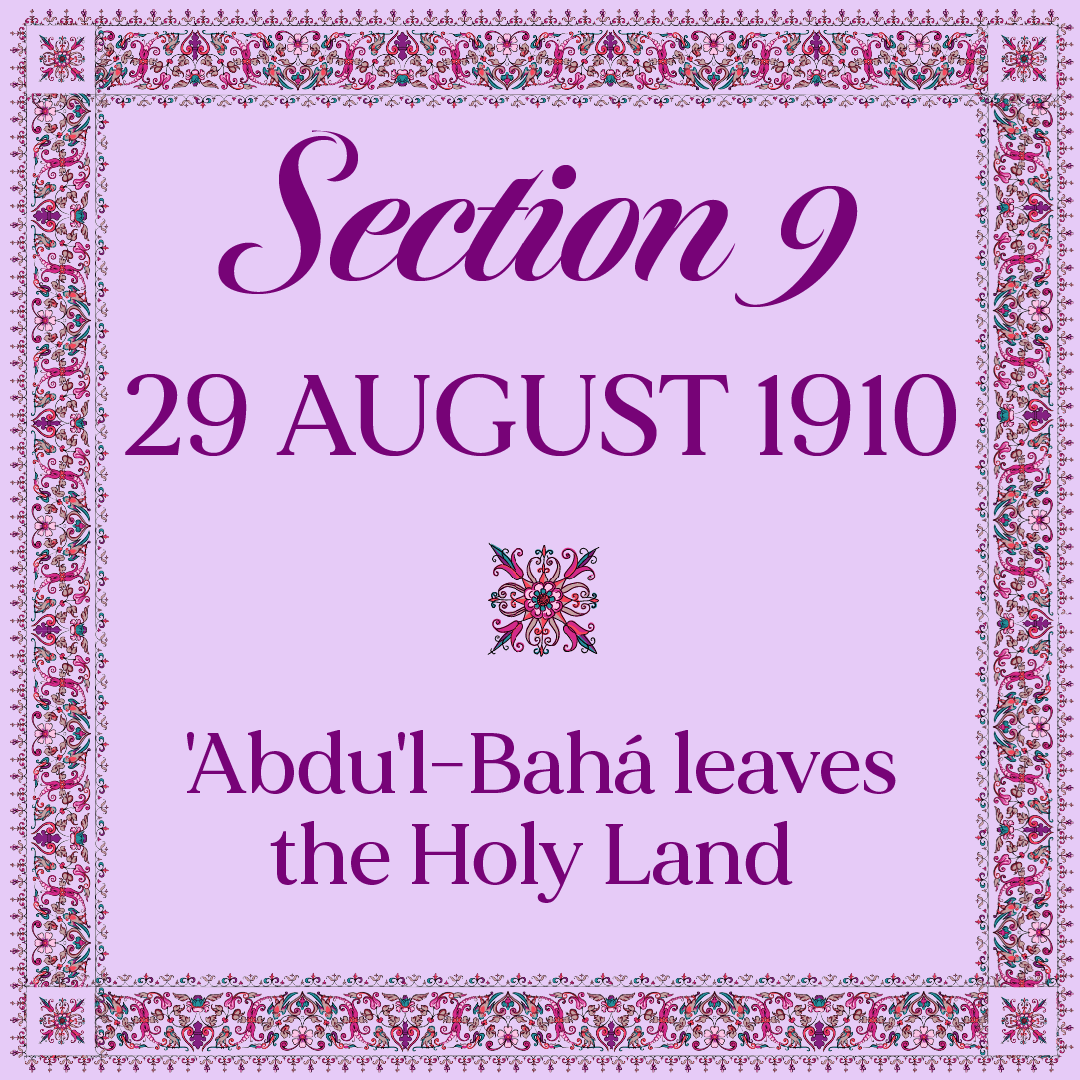

A photograph of the Greatest Holy Leaf taken in Haifa. The young woman standing behind Bahíyyih Khánum has not been identified. © United States National Bahá'í Archives, used with permission.
'Abdu'l-Bahá had designed a monumental plan, which, now that He was no longer a prisoner, He could bring to fruition: He wanted to travel throughout the Western Hemisphere and North America to promulgate the teachings of Bahá'u'lláh.
But in order to fully take advantage of His newfound freedom and the opportunities that were open to Him, it was absolutely essential for 'Abdu'l-Bahá to have someone by His side whom He could fully trust, someone with a stainless character, utmost devotion, immovable steadfastness, and great spiritual strength.
The Greatest Holy Leaf combined all these attributes, along with a sacrificial nature, her lifelong role as her Brother’s loving confident and tireless helper, His selfless supporter and, more importantly than anything else, His trusted deputy.
It was during 'Abdu'l-Bahá’s three-year absence that Bahíyyih Khánum would become the recipient of 'Abdu'l-Bahá’s unbounded affection, constant letters and instructions, kind and loving blessings, and deep appreciation of her virtues and merits.
It is important to note, however, that Bahíyyih Khánum, now 63, was entering old age, and had begun a slow decline due to her advancing age, a fact that did not deter her from serving 'Abdu'l-Bahá. She forgot herself utterly, she refused both rest and comfort, and she served constantly as the hostess of ever-increasing numbers of pilgrims to 'Akká and Haifa.
Her age was never an impediment as she continued to display those immensely rare and pure qualities of character that caused everyone to meet her to be overtaken by love and admiration for her.
With the Greatest Holy Leaf as His deputy in the Holy Land, it was now time for 'Abdu'l-Bahá to prosecute His grand plan and travel and promulgate the Faith of Bahá'u'lláh in the west.
'Abdu'l-Bahá left on 29 August 1910, without informing anyone.
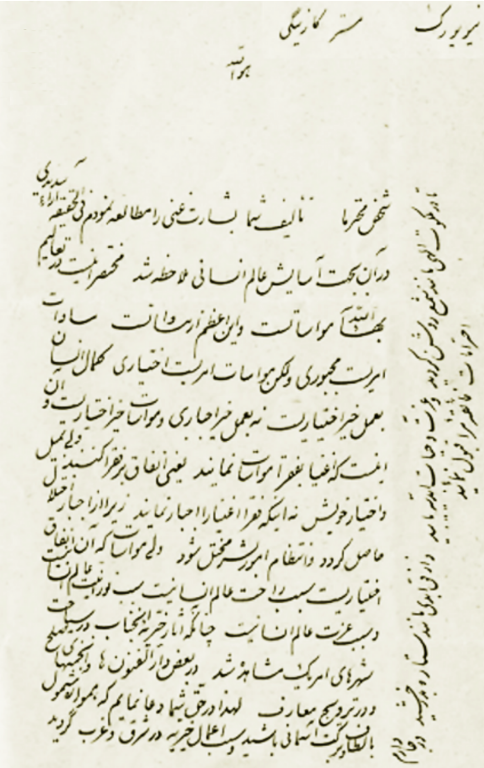
A sample of what 'Abdu'l-Bahá’s handwriting looked like in Tablets. This Tablet was addressed to Andrew Carnegie, the famous philanthropist. Source: Bahá'í Sacred Relics.
Although 'Abdu'l-Bahá left the Holy Land on 29 August 1910 without telling a soul, on the day He left, He revealed a Tablet in honor of the Greatest Holy Leaf informing His beloved sister about His intentions before embarking on His ship:
O thou my sister, my dear sister!
Divine wisdom hath decreed this temporary separation, but I long more and more to be with thee again. Patience is called for, and long-suffering, and trust in God, and the seeking of His favour. Since thou art there, my mind is completely at rest.
In recent days, I have made a plan to visit Egypt, if this be God’s will. Do thou, on my behalf, lay thy head on the sacred Threshold, and perfume brow and hair in the dust of that Door, and ask that I may be confirmed in my work; that I may, in return for His endless bounties, win, if He will, a drop out of the ocean of servitude.
The tenderness and affection of 'Abdu'l-Bahá for His sister is so palpable in these two paragraphs.
It is clear that 'Abdu'l-Bahá was aware He would miss Bahíyyih Khánum immensely during His historic journeys, and the kind gesture of leaving her with a letter speaks volumes about His extraordinary empathy and profound love for the Greatest Holy Leaf.
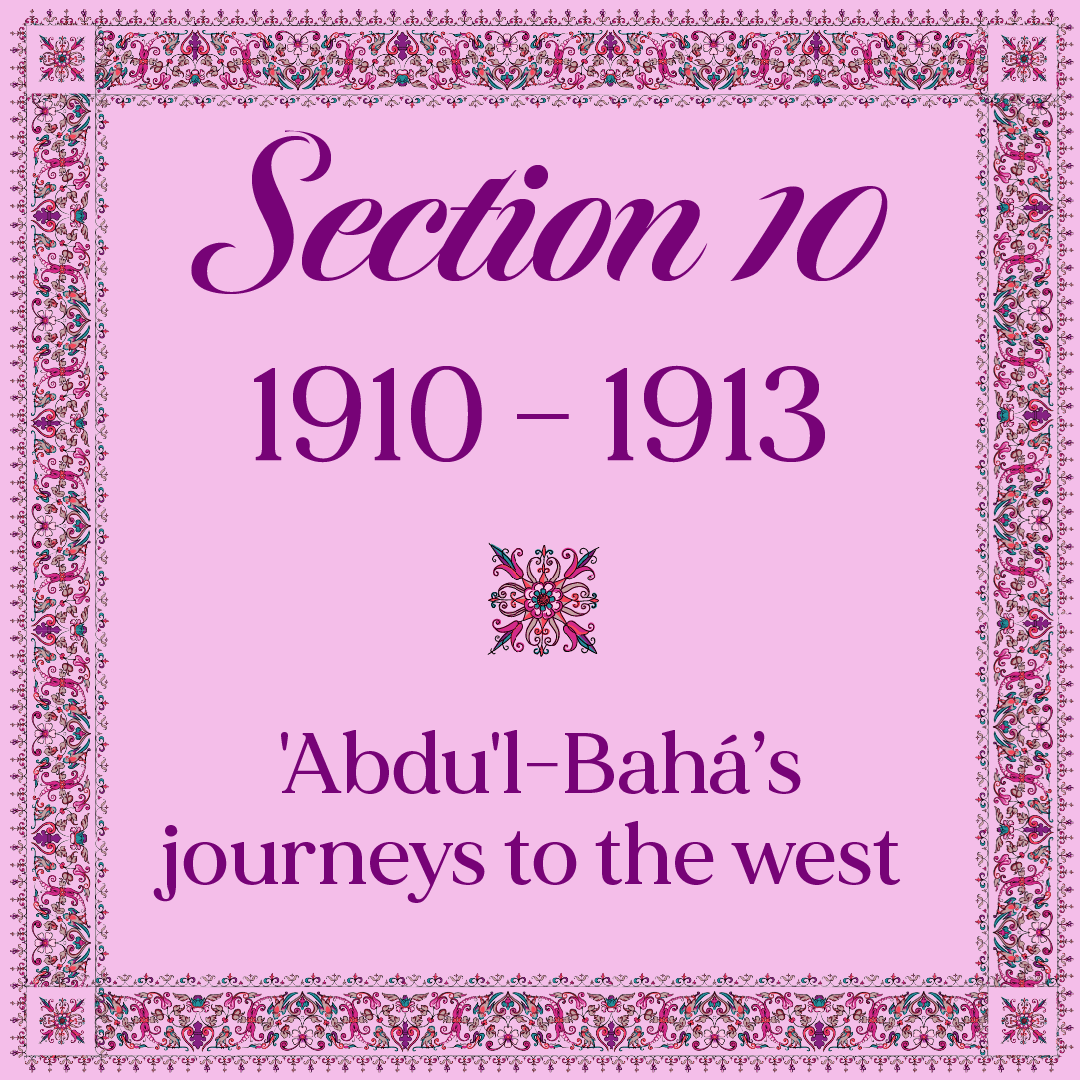

Collage of dates and photographs of every place visited by 'Abdu'l-Bahá during His journeys to Egypt, Europe, and North America.
From 1910 to 1913, 'Abdu'l-Bahá traveled, in order, to Egypt, France, Switzerland, England, France, Egypt, The United States, Canada, England, Scotland, England, France, Germany, Hungary, Austria, Germany, France and Egypt.
During His entire three-year journey, as He spoke in front of audiences of thousands or dozens, in churches, Jewish Temples, or outside mosques, 'Abdu'l-Bahá stayed in constant touch with Bahíyyih Khánum, and the Greatest Holy Leaf, wrote to 'Abdu'l-Bahá constantly. 'Abdu'l-Bahá was informed in great detail about the situation of the family in Haifa, as well as the local Bahá'í community and the Greatest Holy Leaf consulted with Him on a wide range of subjects from the Bahá'í community, the affairs of the Faith, finances, family members, and repairs to be made. 'Abdu'l-Bahá was also in regular touch with His beloved wife, Munírih Khánum.
In His touching letters to His sister, and indeed throughout their lifelong correspondence, 'Abdu'l-Bahá unfailingly addressed her with great marks of love and respect, opening His letters with words such as these:
"O thou my sister, my dear sister" on the ship to Egypt in 1910; "Her Highness, the Greatest Holy Leaf," upon arriving in Paris in 1911; "O thou Greatest and Most Merciful Holy Leaf" in 1912 on arriving in New York; "O My dear sister," "O My cherished sister," "O My sister, the kindred of My spirit," "Dear sister, beloved of my heart and soul," during His journeys; and "O My beloved sister, the Greatest Holy Leaf" upon arriving in Egypt in 1913.
This constant, reciprocal, loving, and respectful correspondence between brother and sister, children of Bahá'u'lláh, and each heroic in their own right, is indicative of another more important relationship: that of the Center of the Covenant with His deputy.
Bahíyyih Khánum kept 'Abdu'l-Bahá informed of all developments, shared with Him her inner thoughts and sought His advice on matters that needed His approval. 'Abdu'l-Bahá, in turn, kept Bahíyyih Khánum constantly informed on the state of his health, the success of His teaching work, and depended on her as a source of clear and straightforward information.
Bahíyyih Khánum was, as His deputy and vicegerent, 'Abdu'l-Bahá’s chosen channel for communication with the local Bahá'í community in the Holy Land and the resident believers.
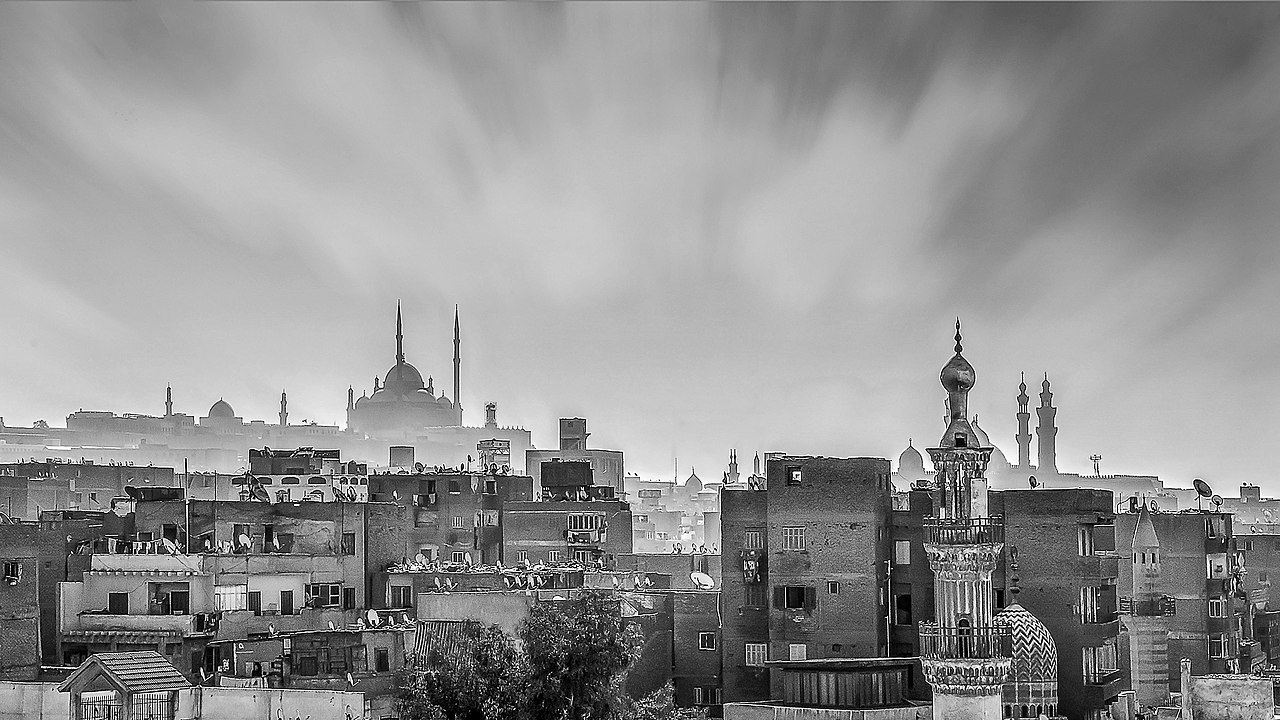
A modern black and white photo of old Cairo, one of the destinations mentioned by 'Abdu'l-Bahá in His Tablet to the Greatest Holy Leaf. Source: Wikimedia Commons.
During His journeys to the west, 'Abdu'l-Bahá deeply, profoundly, missed his beloved sister.
In one of His letters, 'Abdu'l-Bahá once said:
I do not know in what words I could describe my longing for my honoured sister.
An example of the content of their correspondence is a letter from 'Abdu'l-Bahá in which He advises Bahíyyih Khánum to take a short break and travel:
O My sister, the kindred of My spirit!
I have perused all the communications that were sent. Regarding a trip to Alexandria, Cairo, Port Said and also from there to Beirut, do thou consider what is best for thee. Whatever leads to an improvement in thy health, the same should be carried out. If the weather proves disagreeable, thou mayest go to Beirut and stay in the home of Jinab-i-Muḥammad Muṣṭafá, upon him be Bahá'u'lláh’u'l-Abhá.
Also, shouldst thou desire to go to Jibal from there, that, too, is permissible. Or shouldst thou wish, we could obtain a place specially for thee in Haifa. Do thou write soon about thy decision.
Convey Abhá greetings on My behalf to all the blessed leaves and also to all the friends. There is no time to mention them one by one.
P.S. I have given Aqa Muḥammad-Taqí the sum of 30 Liras to give to thee. Thou mayest get from 'Aqa Siyyid Yaḥyá [Munírih Khanum's brother] what thou need. I will pay him later.
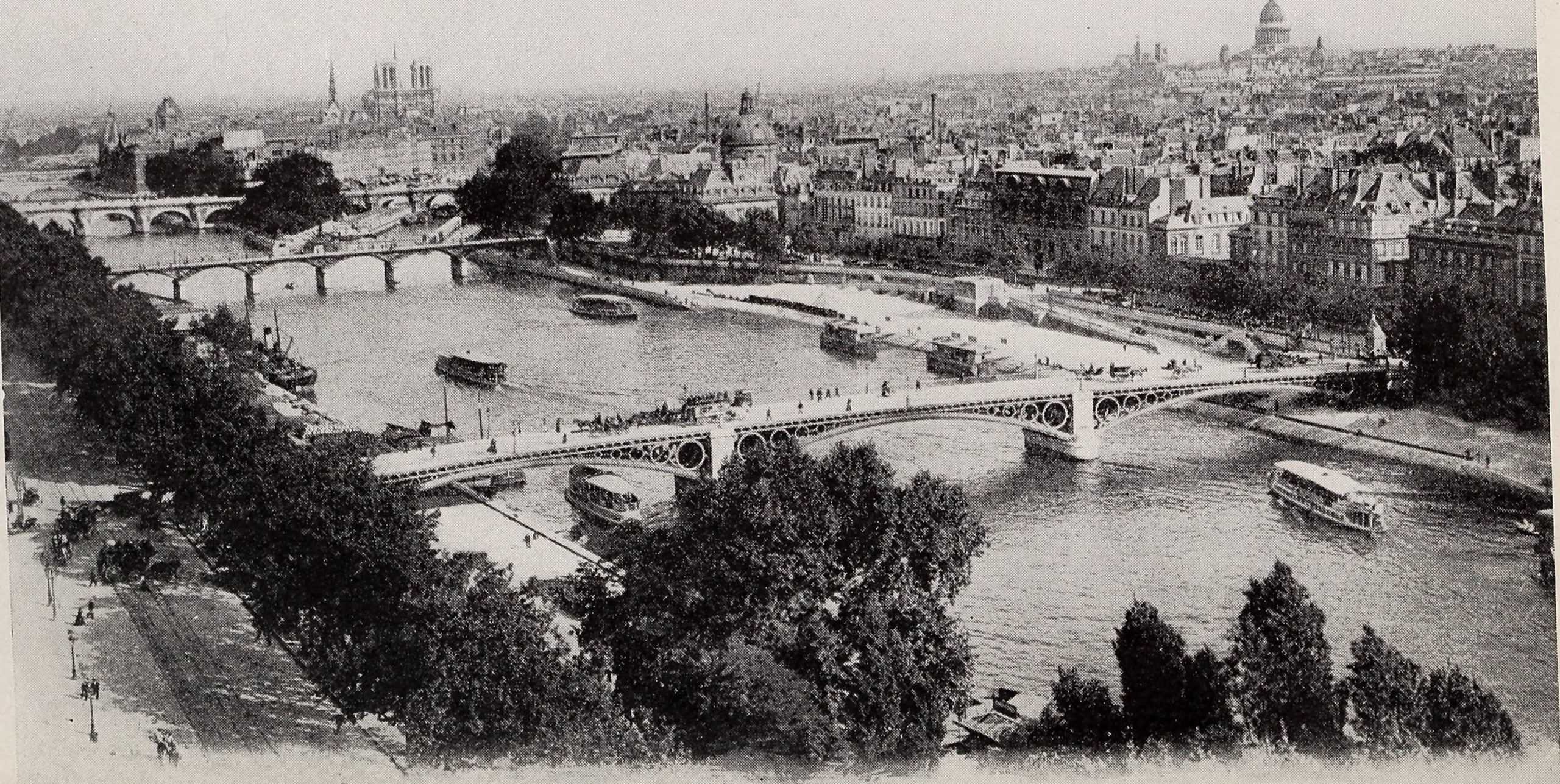
Paris in 1913. Source: Wikimedia Commons.
After His arrival in France, 'Abdu'l-Baha sent the following Tablet to Bahíyyih Khánum:
Her Highness, the Greatest Holy Leaf, upon her be Bahá'u'lláhu'l-Abhá! He is the Glory of the Most Glorious! O My beloved sister!
Through the bounties of the Blessed Beauty, may My spirit be sacrificed for His Blessed Dust, we have traversed the expanse of deep seas, and have, under the loving protection of the Most Great Name, passed through ports and gulf straits.
We are now staying at Grant Hotel in Thonon on the shore of Lake Swiss, thinking of thee and remembering thee. The beauty of the scenery, the pleasantness of the place, the purity of the water, the charm of the horizon, the softness of the breeze, and the lushness of the mountain have combined to produce an extraordinary sight better than which cannot be imagined. However, 'Abdu'l-Baha is so busied with work and writing that He has no time to look [at the scenery.
But the climate is agreeable. It is hoped that through the favours of the Ancient Beauty, this broken winged gnat will be so strengthened in servitude to the Threshold of the Desired One as to extend new wings. He taketh every breath with such hope, and all dependeth on His aid.
Yea! I swear by the Sacred Dust that the sandy earth beyond 'Akká is so filled with spirituality and luminosity that one span of it is preferable to a thousand gardens, parks, lawns and meadows of this country, for the soil of that land is luminous and its billowing sea high as the firmament. His grace causes its breeze to blow.
Its fragrance is the smell of strong-scented musk, its desert the valley of trust, its expanse the Blessed Shrine, and a place blooming with flowers and roses. Therefore, notwithstanding separation from that land, for the people of faith, this is like a prison and portico narrow and dark.
Hence, I expect of thee, at the time of visiting the Sacred Court, to place thy face on that perfumed dust, kiss the Holy Threshold, and beseech aid and assistance that 'Abdu'l-Baha may take a breath in serving that Threshold. Convey My utmost love and eagerness to the blessed leaf, My sister Furúghíyyih Khanum. She is always in my thoughts. Also, convey My Abhá greetings to her mother.
The water pump for the Shrine Garden has no doubt been installed by now.
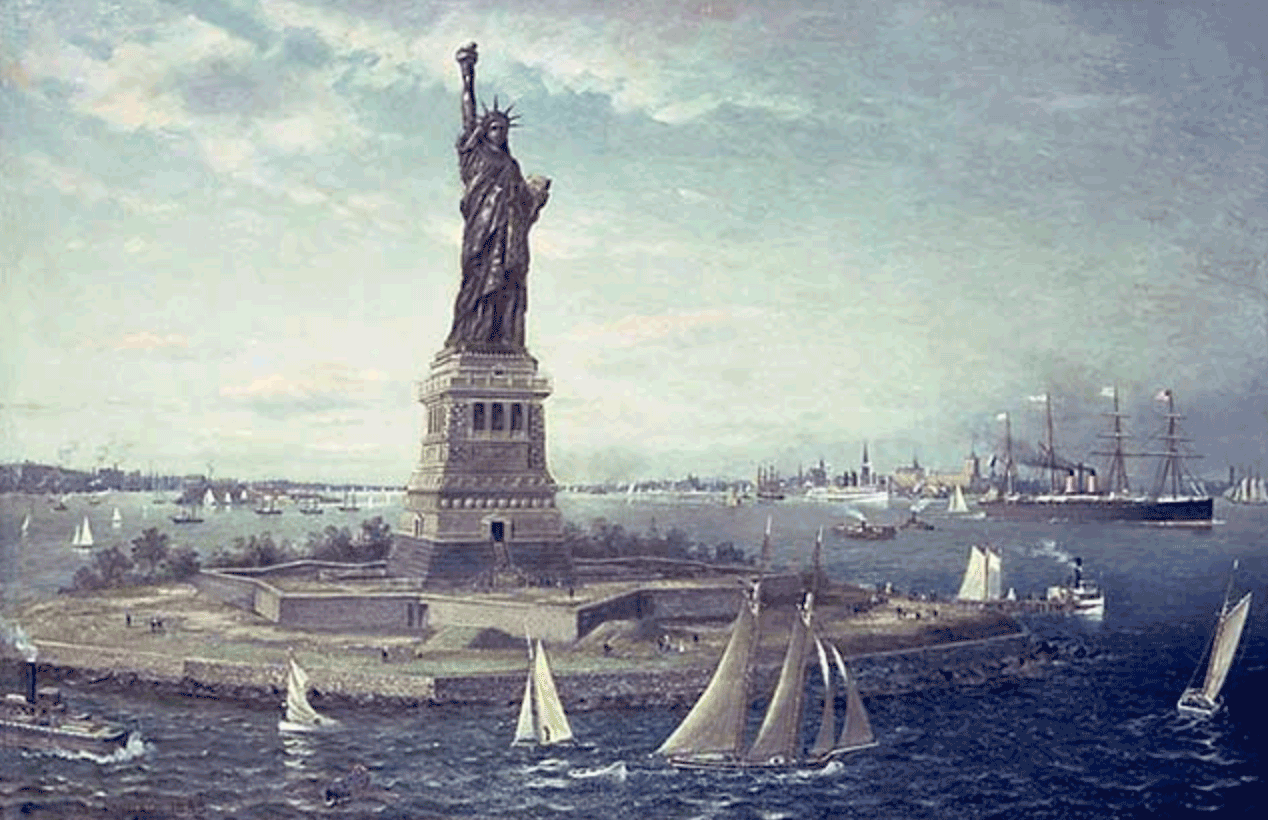
1912 painting by Fred Pansing with sailboats and a steamship passing in the background. Source: Wikimedia Commons.
Upon His arrival in New York 'Abdu'l-Bahá wrote:
O thou Greatest and Most Merciful Holy Leaf!
I arrived in New York in the best of health, and I have been at all times thinking of thee, and supplicating fervently at the threshold of the Blessed Beauty that He may guard thee in the stronghold of His protection.
We are in the utmost fellowship and joy. I hope that thou wilt be sheltered under His bountiful care. Write to me at once about Rúḥá Khánum’s and Shoghi Effendi's condition, informing me fully and hiding nothing; this is the best way. Convey my utmost longing to all.
In another Tablet He said:
O My cherished sister!
Thou art never absent from my thoughts. I speak of thee and call thee to mind at all times. It is my hope that out of God's favour and grace thou mayest keep well and safe, and dost visit the two Sacred Thresholds on my behalf.
The depth of the bond which existed between ‘Abdu’l-Bahá and His sister is clearly evident in the love pouring out of His letters to her during His stay in Europe and America. His prolonged absence meant a prolonged separation from the person He loved the most, and He knew that it also meant more and more responsibility for the Greatest Holy Leaf in the Holy Land.
But 'Abdu'l-Bahá’s letters of love and kindness to the Greatest Holy Leaf assuaged the pain in His heart and also brought immense joy to Bahíyyih Khánum, who was constantly filled with joy at her adored Brother’s success in the west, in those lands so distant from where she was:
O thou my affectionate sister!
In the daytime and in the night-season my thoughts ever turn to thee. Not for one moment do I cease to remember thee. My sorrow and regret concern not myself; they centre around thee. Whenever I recall thine afflictions, tears that I cannot repress rain down from mine eyes…


A photograph of the House of the Master by Farzam Sabetian. Source: Luminous Spot.
'Abdu'l-Bahá invested His saintly and honored sister with the responsibility of attending to the multitude of details which arose during His long absence from the Holy Land, at a time when the Covenant-breakers were actively pursuing their evil goals of rivaling with 'Abdu'l-Bahá’s authority.
'Abdu'l-Bahá nominated and appointed Bahíyyih Khánum as His vicegerent and deputy and empowered her through this appointment to stand in form Him during His long absence. In this vital role, she was the administrator of the affairs of the Faith, and exercised authority in their management.
Her role would be far-reaching during 'Abdu'l-Bahá’s long journeys to the west, and she attended to the needs of the Bahá'í community, providing both administrative and spiritual guidance, as well as managing the affairs of the Faith in the Holy Land, receiving dignitaries and officials—both men and women—inspired visiting pilgrims, ministered to the needs of the poor, and provided medical assistance to the sick.
In the words of Shoghi Effendi:
At the time of His absence in the western world, she was His competent deputy, His representative and vicegerent, with none to equal her.

Bahá'í visitors at the Shrine of the Báb in Haifa in 1910. Source: Bahaimedia.
'Abdu'l-Bahá's long absence of three years helped lay the ground for the Greatest Holy Leaf to deploy her leadership abilities on a much wider scale than before and prepared her for assuming this same role of deputy during the Guardianship.
When 'Abdu'l-Bahá and Shoghi Effendi each took on the mantle of Head of the Bahá'í Faith, respectively as Center of the Covenant and Guardian of the Faith, both times it was the Greatest Holy Leaf who ably, wisely, and firmly steered the ship and protected the Covenant until they had recuperated from the tremendous shock and weight of the responsibilities and were able to fully assume their sacred duties and bear the weight of their crushing responsibilities.

'Abdu'l-Bahá addressing the 300 guests inside the tent before the laying of the foundation stone. National Baha'i Archives of the Bahá'ís of the United States.
‘Abdu’l-Bahá’s historic journeys to the west would forever be the most thrilling period of Bahíyyih Khánum’s life.
For the Greatest Holy Leaf, the most important thing in the entire world was the growth of her beloved Father’s Faith.
Nothing could ever have surpassed for her the epic victories of very own Brother, the son of Bahá'u'lláh and the Center of the Covenant in these distant lands of North America and Europe, spreading and propagating the teachings of the Bahá'í Faith in person and through the vast media coverage He received.
The moment 'Abdu'l-Bahá set foot in Europe and North America, Bahíyyih Khánum was flooded with thrilling messages about 'Abdu'l-Bahá’s victories in teaching and the propagation and establishment of the Faith in France, England, Scotland, the United States and Canada, Germany, Hungary and Austria, and recounting the extraordinary and irresistible advance of the Faith of her beloved Father, in the most incredible manner.
Despite her many responsibilities as 'Abdu'l-Bahá’s deputy in the Holy Land, these were the brightest and happiest years of her life as she reveled in 'Abdu'l-Bahá’s extraordinary feat, the highlight of His entire ministry.
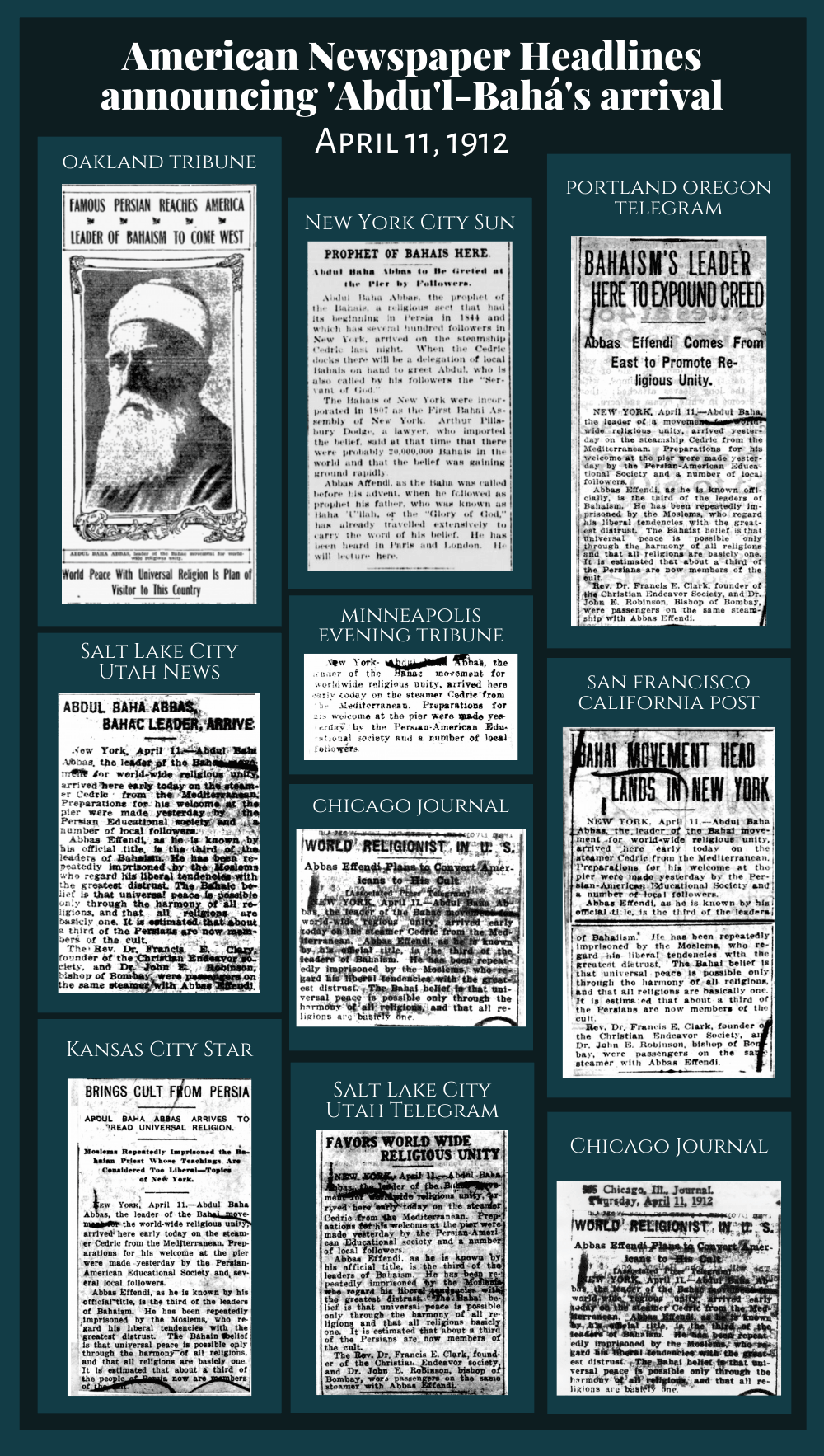
New York Sun headline from Library of Congress. Remaining newspaper headlines from 'Abdu'l-Bahá in America: 1912-201; April 11, 1912.
In many of ‘Abdu'l-Bahá’s letter to His cherished sister, He Himself marveled at the receptivity of His western audiences. In one of His Tablets to Bahíyyih Khánum, 'Abdu'l-Bahá even revealed a special prayer for her to recite in the Shrine of Bahá'u'lláh on His behalf:
O My dear sister!
Praise be to God, within the sheltering grace of the Blessed Beauty, here in the lands of the West a breeze hath blown from over the rose-gardens of His bestowals, and the hearts of many people have been drawn as by a magnet to the Abhá Realm.
Whatever hath come to pass is from the confirmations of the Beloved; for otherwise, what merit had we, or what capacity? We are as a helpless babe, but fed at the breast of heavenly grace. We are no more than weak plants, but we flourish in the spring rain of His bestowals.
Wherefore, as a thank-offering for these bounties, on a certain day don thy garb to visit the Shrine…turn thyself toward Him on my behalf, lay down thy head on that sacred Threshold, and say:
O divine Providence! O Thou forgiving Lord! Sinner though I be, I have no refuge save Thyself. All praise be Thine, that in my wanderings over mountains and plains, my toils and troubles on the seas, Thou hast answered still my cries for help, and confirmed me, and favoured me, and honoured me with service at Thy Threshold.
To a feeble ant, Thou hast given Solomon’s might. Thou hast made of a gnat a lion in the thicket of Thy Mercy. Thou hast bestowed on a drop the swelling waves of the sea, Thou hast carried up a mote to the pinnacles of grace. Whatever was achieved, was made possible through Thee. Otherwise, what strength did the fragile dust possess, what power did this feeble being have?
O divine Providence! Do not seize us in our sins, but give us refuge. Do not look upon our evil ways, but grant forgiveness. Consider not our just deserts, but open wide Thy door of grace.
Thou art the Mighty, the Powerful! Thou art the Seer, the Knower!
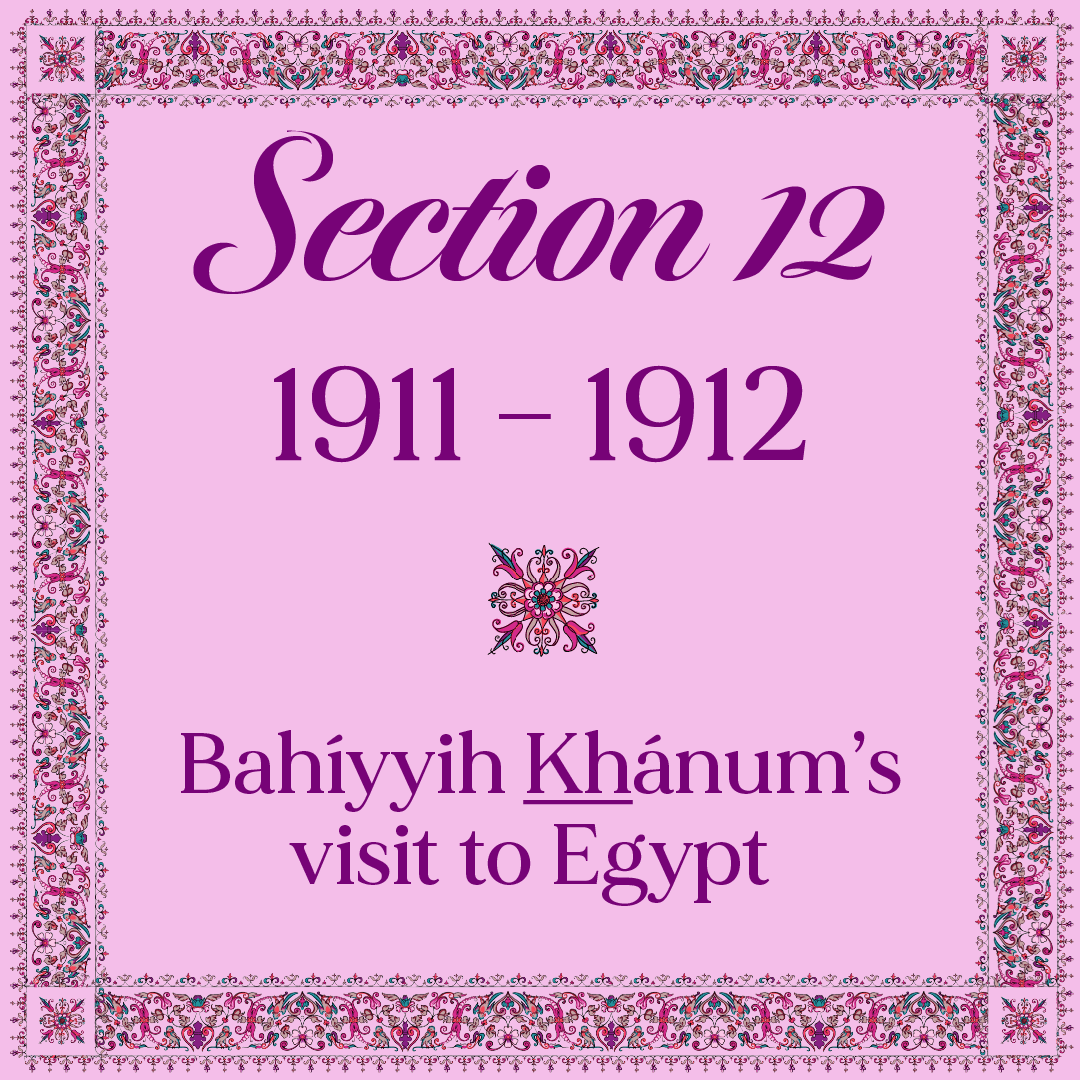
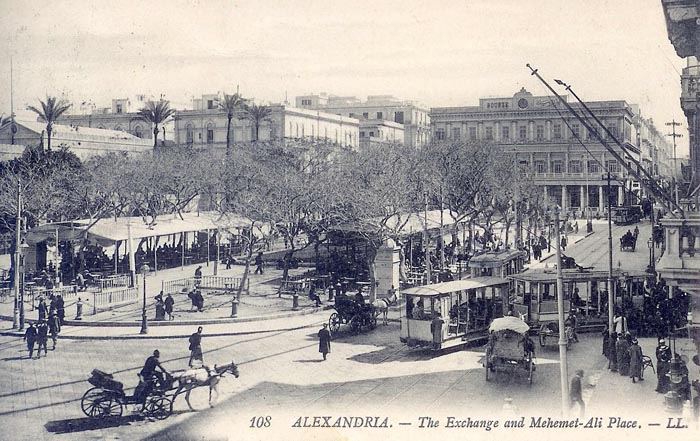
As a symbolic illustration of the visit of the Greatest Holy Leaf’s 1911 – 1912 visit to Egypt, a 1910 postcard of Alexandria, Egypt, where the Holy Family often went when in Egypt. Albumen print 1886. Source: Wikimedia Commons.
At some point between 1911 and 1912, when 'Abdu'l-Bahá was in Europe and North America, the Greatest Holy Leaf made a trip to Egypt, which we know about through a Tablet from 'Abdu'l-Bahá:
Dear sister, beloved of my heart and soul!
The news of thy safe arrival and pleasant stay in the land of Egypt has reached me and filled my heart with exceeding gladness.
I am thankful to Baha'u'llah for the good health thou dost enjoy and for the happiness He hath imparted to the hearts of the loved ones in that land.
Shouldst thou wish to know of the condition of this servant of the Threshold of the Abhá Beauty, praise be to Him for having enabled me to inhale the fragrance of His tender mercy and partake of the delights of His loving-kindness and blessings.
I am being continually reinforced by the energizing rays of His grace, and feel upheld by the uninterrupted aid of the victorious hosts of His Kingdom.
My physical health is also improving. God be praised that from every quarter I receive the glad-tidings of the growing ascendancy of the Cause of God, and can witness evidences of the increasing influence of its spread...

A 1910 – 1920 postcard of Alexandria, Egypt, where the Holy Family often went when in Egypt. Albumen print 1886. Source: Wikimedia Commons.
During the Greatest Holy Leaf’s 1911/1912 stay in Egypt, 'Abdu'l-Bahá wrote a thoughtful letter to one of His daughters who had accompanied her aunt, showing how much 'Abdu'l-Bahá loved and cared for His precious and treasured sister, even during what must have been the busiest time of His entire life, during His journeys to the west:
It is incumbent upon thee throughout the journey to be a close, a constant and cheerful companion to My honorable and distinguished sister.
Unceasingly, with the utmost vigor and devotion, exert thyself by day and night to gladden her blessed heart; for all her days she was denied a moment of tranquillity. She was astir and restless every hour of her life.
…Mothlike she circled around the undying flame of the divine Candle, her spirit ablaze and her heart consumed by the fire of His Love.
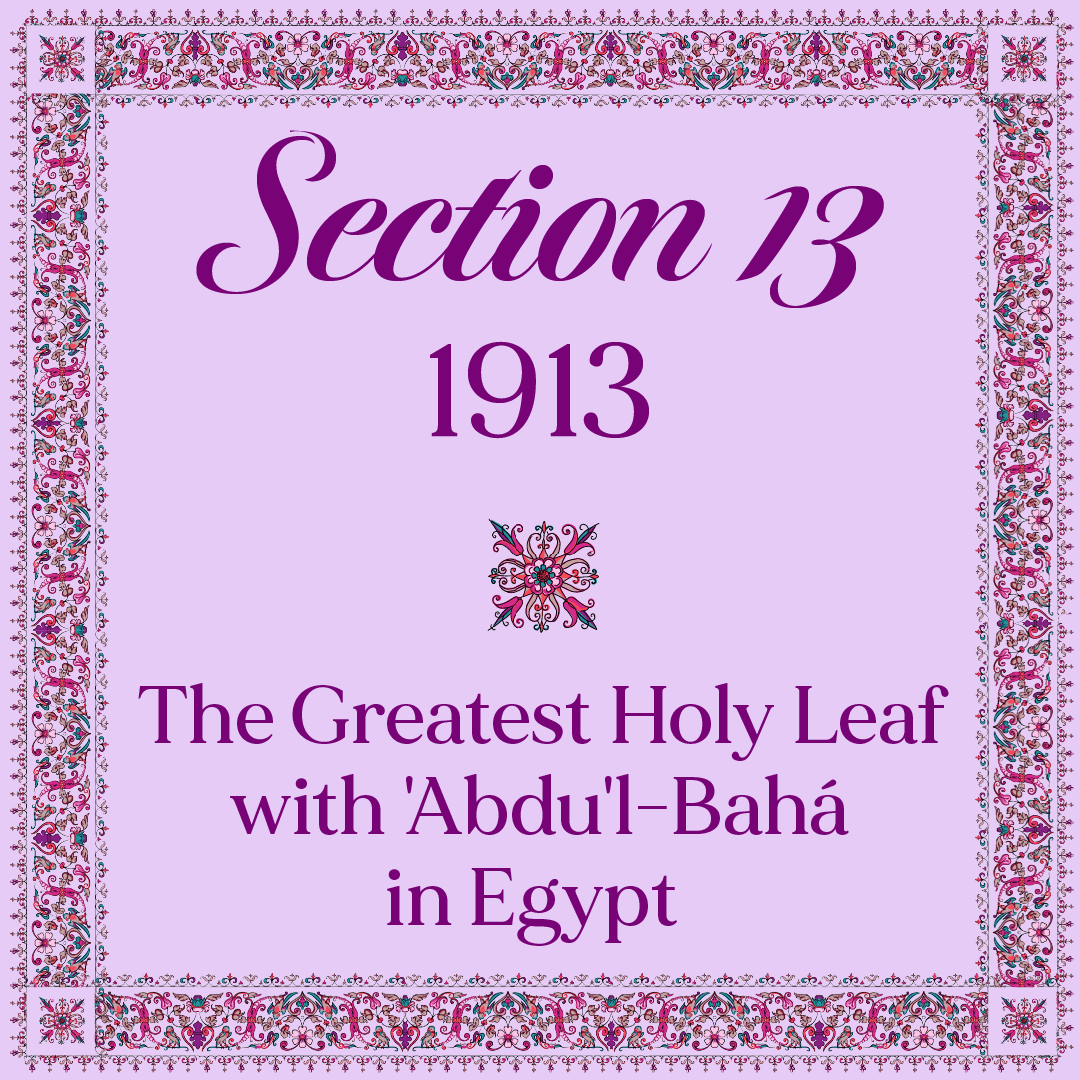
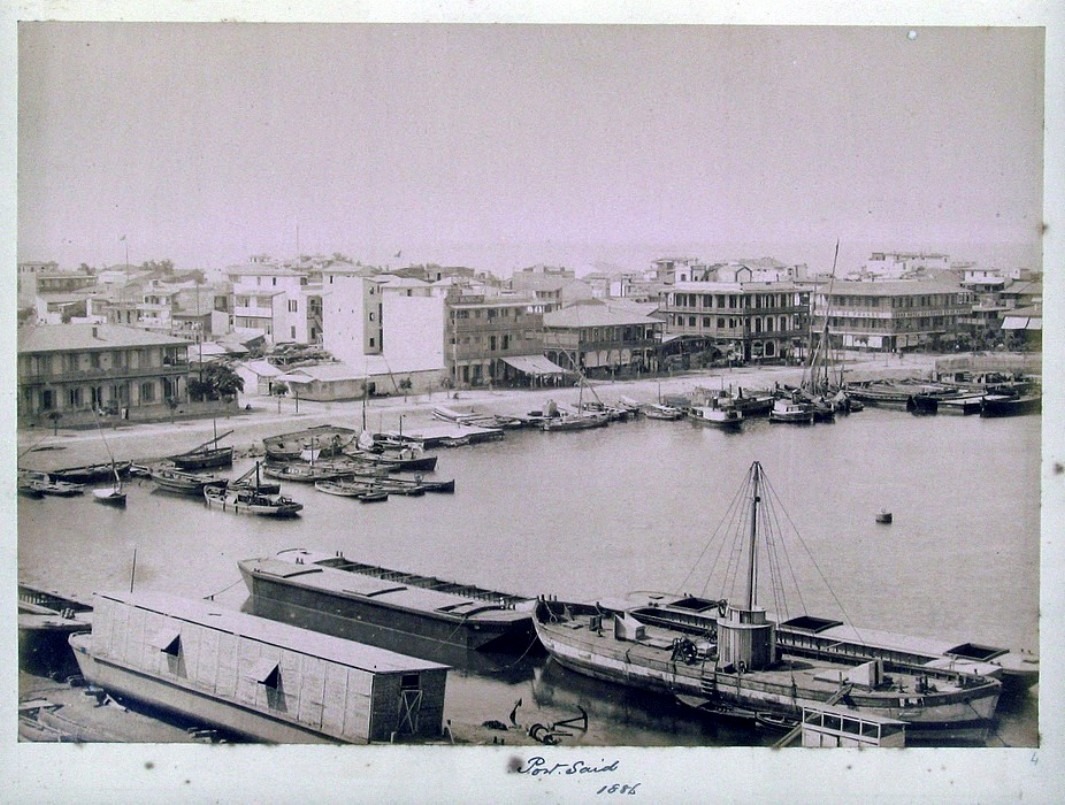
View of Port-Said, Egypt where 'Abdu'l-Bahá arrived on 17 June 1913. Albumen print 1886. Source: Wikimedia Commons.
When 'Abdu'l-Bahá arrived in Port Said, three things happened in short succession:
First, 'Abdu'l-Bahá decided not to return to the Holy Land immediately.
Second, He sent a cable asking the gathered pilgrims in Haifa who were waiting for Him in the Holy Land to make their way to Port Said.
And third: He wrote a letter to His beloved sister, the Greatest Holy Leaf, asking her to make preparations to join Him in Egypt. Part of 'Abdu'l-Bahá’s letter to Bahíyyih Khánum reads:
O My beloved sister, the Greatest Holy Leaf!
My eagerness knows no bound. I have not seen thee for such a long time.
My coming to Haifa is somewhat delayed. If possible, come soon to Port Said.
Perhaps we could return together to the Holy Land ...
Back in Haifa, the Greatest Holy Leaf was managing 'Abdu'l-Bahá’s household and attending to her many administrative and management duties.
Pilgrims were arriving from every part of the world, including a number of western women who had the honor of residing in the house of the Master. Among these women were Lua Getsinger and Isobel Fraser.
The Greatest Holy Leaf would leave her responsibilities in Haifa for a while in order to finally enter into 'Abdu'l-Bahá’s presence after nearly three years of not having laid eyes on her adored Brother.
It would be an unforgettable experience.
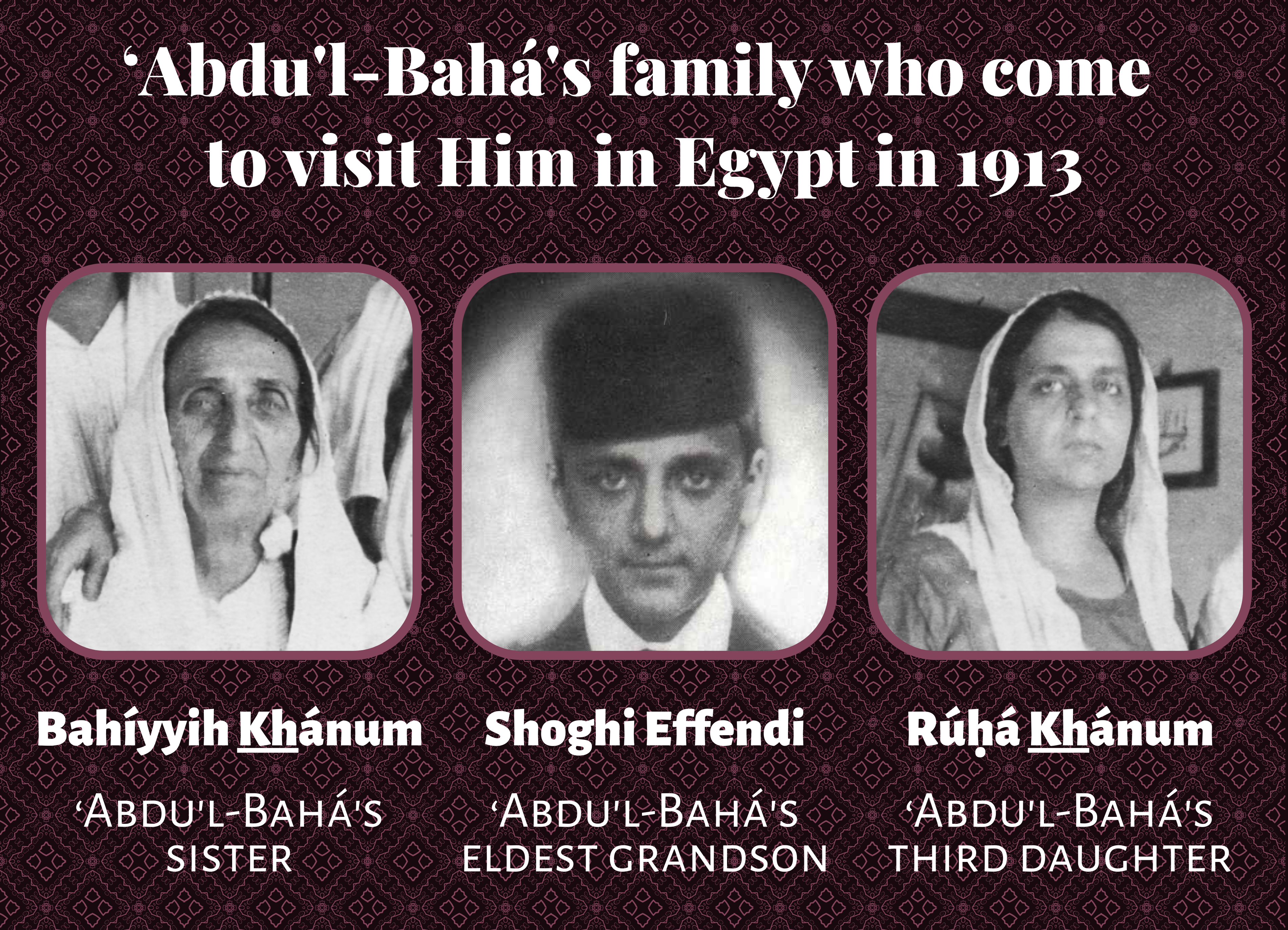
Bahíyyih Khánum, Shoghi Effendi, and Rúḥa Khánum, the aunt of Shoghi Effendi and daughter of 'Abdu'l-Bahá.
Bahíyyih Khánum, Shoghi Effendi, 16 years old, his mother and one of his aunts, arrived in Alexandria on 1 August 13, 45 days after 'Abdu'l-Bahá.
They would have all come sooner, but Shoghi Effendi was still in school at the Syrian Protestant College in Beirut, and they had to wait for his school year to end.
In Ramleh, 'Abdu'l-Bahá had rented a villa for the family.
During 'Abdu'l-Bahá's journeys to the West, Shoghi Effendi, who had subscribed to Star of the West, avidly followed his beloved grandfather's exploits, sometimes writing to the editors when his issue was late in arriving.
Shoghi Effendi said that these years of 'Abdu'l-Bahá's journeys to the West, when the Greatest Holy Leaf "basked in the sunshine of ‘Abdu’l-Bahá’s spiritual victories," were perhaps among the brightest and happiest of her life: her beloved Brother, the Center of the Covenant, achieving in distant countries and foreign nations the greatest and most memorable of His victories for their Father's magnificent Faith.
Shoghi Effendi provides a fascinating description of the emotions that surged in the heart of the Greatest Holy Leaf when she was reunited with 'Abdu'l-Bahá in Egypt:
The enthusiasm and joy which swelled in her breast as she greeted 'Abdu'l-Bahá on His triumphant return from the West, I will not venture to describe. She was astounded at the vitality of which He had, despite His unimaginable sufferings, proved Himself capable. She was lost in admiration at the magnitude of the forces which His utterances had released. She was filled with thankfulness to Bahá'u'lláh for having enabled her to witness the evidences of such brilliant victory for His Cause no less than for His Son.
The Greatest Holy Leaf, Shoghi Effendi and Rúḥíyyih Khánum stayed in Egypt for a few weeks, then they returned to Haifa so that Bahíyyih Khánum could take care of the pilgrims and manage the affairs of the community.
SOURCES FOR PART VII
1901-1905: Bahíyyih Khánum and the Holy Family’s attitude during this time of danger
Prophet’s Daughter: The Life and Legacy of Bahíyyih Khánum, Outstanding Heroine of the Bahá’í Faith, Janet A. Khan, Bahá’í Publishing Trust, Wilmette, 2005, pages 71-72.
1906 and 1908: ‘Abdu’l-Bahá reveals His Will and Testament
Child of the Covenant: A Study Guide to the Will and Testament of ‘Abdu’l-Bahá, Adib Taherzadeh, George Ronald, 2000, page 7.
Many thanks to Larry Roefner for his email communication dated 11 February 2024, providing this source which allows us to precisely date the first part of the Will and Testament of ‘Abdu’l-Bahá to 1906, rather than 1901 as is so commonly thought.
REFERENCE REGARDING THE GREATEST HOLY LEAF:
The Greatest Holy Leaf’s Unparalleled Role in Religious History and the Significance of the Arc, the Site of Her Resting Place, Baharieh Rouhani Ma’ani, published in Lights of Irfan, 15, pages 199-228, Wilmette: Haj Mehdi Armand Colloquium, 2014, page
NOTE REGARDING THE DATES AS 1906-1908 INSTEAD OF THE USUALLY QUOTED DATES OF 1901-1908.
It is often believed that ‘Abdu’l-Bahá’s Will and Testament was written in two parts, in 1901 and 1908. This, however was before extensive research on the part of eminent Bahá’í historian Adib Taherzadeh, who was able to more precisely date the first part of ‘Abdu’l-Bahá’s Will and Testament to 1906. Below is Mr. Taherzadeh’s explanation in Child of the Covenant: A Study Guide to the Will and Testament of ‘Abdu’l-Bahá, page 7:
The Will and Testament, described by Shoghi Effendi as the Charter of the New World Order, was written in ‘Abdu’l-Bahá’s own hand and is signed and sealed by Him. It consists of three parts, written at different times during the darkest days of ‘Abdu’l-Bahá’s life, when He was living in the house of ‘Abdu’lláh Páshá. ‘Abdu’l-Bahá was incarcerated in the fortress city of ‘Akká through the machinations and intrigues of Mírzá Muḥammad-‘Alí, the arch-breaker of the Covenant, who was ably assisted by his brothers and other Covenant- breakers. The date on which each part was written is not given but the first part of the Will is likely to have been written sometime in 1906 or later14.
Note 14 from Mr. Taherzadeh: One clue to the date of the Will’s completion is that Shu‘á‘u’lláh, a son of Mírzá Muḥammad-‘Alí, sent a letter from the United States to Majdu’d-Dín, the arch-enemy of ‘Abdu’l-Bahá, dated 27 Tiashrín 2nd (27 November) 1905. Somehow this letter came into the possession of ‘Abdu’l-Bahá. He refers to this letter in the first part of the Will and Testament (see Will and ‘Testament paragraph 9). Bearing in mind the time it took for the letter to reach the Holy Land by surface post, and not knowing when or how it fell into ‘Abdu’l-Bahá’s hands, it is reasonable to assume that the first part of the Will was written sometime in 1906 or later.
The Greatest Holy Leaf’s gentle authority as head of the household
Prophet’s Daughter: The Life and Legacy of Bahíyyih Khánum, Outstanding Heroine of the Bahá’í Faith, Janet A. Khan, Bahá’í Publishing Trust, Wilmette, 2005, pages 87-88, 90-91 and 93-94.
Bahíyyih Khánum and the Ladies’ Room
Prophet’s Daughter: The Life and Legacy of Bahíyyih Khánum, Outstanding Heroine of the Bahá’í Faith, Janet A. Khan, Bahá’í Publishing Trust, Wilmette, 2005, pages 88-89.
Custodian of the holy relics of the Faith
Prophet’s Daughter: The Life and Legacy of Bahíyyih Khánum, Outstanding Heroine of the Bahá’í Faith, Janet A. Khan, Bahá’í Publishing Trust, Wilmette, 2005, pages 89-90.
Bahíyyih Khánum and the women pilgrims
Prophet’s Daughter: The Life and Legacy of Bahíyyih Khánum, Outstanding Heroine of the Bahá’í Faith, Janet A. Khan, Bahá’í Publishing Trust, Wilmette, 2005, pages 92-95.
Prophet’s Daughter: The Life and Legacy of Bahíyyih Khánum, Outstanding Heroine of the Bahá’í Faith, Janet A. Khan, Bahá’í Publishing Trust, Wilmette, 2005, pages 92-95.
Bahíyyih Khánum’s letters to pilgrims
Prophet’s Daughter: The Life and Legacy of Bahíyyih Khánum, Outstanding Heroine of the Bahá’í Faith, Janet A. Khan, Bahá’í Publishing Trust, Wilmette, 2005, pages 92-95.
Lunch in the time of ‘Abdu’l-Bahá
The Priceless Pearl, Rúḥíyyih Rabbání, Bahá’í Publishing Trust, London, 1969, pages 14-15.
Email communication from Adib Masumian dated 4 February 2024 regarding the correct transliteration of “Qulí, sá‘at chandih?” and “bíyá bishíníd.”
Shoghi Effendi and Bahíyyih Khánum: A profound, spiritual love
The Priceless Pearl, Rúḥíyyih Rabbání, Bahá’í Publishing Trust, London, 1969, pages 6-7.
Bahá’í Library Online: Pilgrimage to Haifa and ‘Akká: Parts 2 and 3, (Part 1 missing), Bill Sears, page 4.
1907: ‘Abdu’l-Bahá mentions Shoghi Effendi in a Tablet to Bahíyyih Khánum in Haifa
Leaves of the Twin Divine Trees, Baharieh Rouhani Ma’ani, George Ronald, Oxford, 2013, pages 168-169.
Bahíyyih Khánum: The Greatest Holy Leaf by Bahá’u’lláh, Abdu’l-Bahá, Shoghi Effendi, and Bahíyyih Khánum, compiled by Research Department of the Universal House of Justice Haifa: Bahá’í World Centre Publications (1982): (in the order in which they are quoted in this section): Selections 19, 14, and 17 from the Writings of ‘Abdu’l-Bahá, pages 17,15, and 16-17.
The Greatest Holy Leaf’s short trip to Haifa
Leaves of the Twin Divine Trees, Baharieh Rouhani Ma’ani, George Ronald, Oxford, 2013, pages 168-169.
Bahíyyih Khánum: The Greatest Holy Leaf by Bahá’u’lláh, Abdu’l-Bahá, Shoghi Effendi, and Bahíyyih Khánum, compiled by Research Department of the Universal House of Justice Haifa: Bahá’í World Centre Publications (1982): (in the order in which they are quoted in this section): Selections 19, 14, and 17 from the Writings of ‘Abdu’l-Bahá, pages 17,15, and 16-17.
The Greatest Holy Leaf’s trip to Nazareth
Leaves of the Twin Divine Trees, Baharieh Rouhani Ma’ani, George Ronald, Oxford, 2013, pages 168-169.
Bahíyyih Khánum: The Greatest Holy Leaf by Bahá’u’lláh, Abdu’l-Bahá, Shoghi Effendi, and Bahíyyih Khánum, compiled by Research Department of the Universal House of Justice Haifa: Bahá’í World Centre Publications (1982): (in the order in which they are quoted in this section): Selections 19, 14, and 17 from the Writings of ‘Abdu’l-Bahá, pages 17,15, and 16-17.
February 1907: Corinne True’s experience with Bahíyyih Khánum
Corrine True: Faithful Handmaid of ‘Abdu’l-Bahá, Nathan Rutstein, George Ronald, 1987, page 64-65.
January – July/August 1908: English lessons in ‘Akká
Visiting ‘Abdu’l-Bahá: Volume 1: The West Discovers the Master, 1897-1911. Earl Redman, George Ronald Publishers, Oxford, 2019, Chapter: 1908 (year).
21 March 1909: ‘Abdu’l-Bahá lays the remains of the Báb to rest
Balyuzi, H.M. ‘Abdu’l-Bahá: The Centre of the Covenant, page 131.
Prophet’s Daughter: The Life and Legacy of Bahíyyih Khánum, Outstanding Heroine of the Bahá’í Faith, Janet A. Khan, Bahá’í Publishing Trust, Wilmette, 2005, page 75.
Wikipedia: Young Turk Revolution.
Journey to a Mountain: The Story of the Shrine of the Báb, Volume 1: 1850-1921, Michael V. Day, George Ronald, 2017, pages 40, 51, and 76.
Violetta Zein, The Extraordinary Life of ‘Abdu’l-Bahá: The illustrated chronology of the life of ‘Abdu’l-Bahá Part IV: The Center of the Covenant.
Violetta Zein, The Guardian: The illustrated chronology of the life and work of Shoghi Effendi: Section 8: 21 March 1909: Shoghi Effendi is present when ‘Abdu’l-Bahá lays the Báb’s remain to rest.
August 1910: Bahíyyih Khánum and the Holy Family move to Haifa
Michael Day: Journey to a Mountain page 63.
Rabbání, Rúḥíyyih. The Priceless Pearl, page 13.
After 1910: Bahíyyih Khánum’s informal orphanage
Memoirs of Dr. Ḥabíb Mu’ayyad, in Payam-i-Bahá’í, Number 33, page 12.
Leaves of the Twin Divine Trees, Baharieh Rouhani Ma’ani, George Ronald, Oxford, 2013, page 398.
Bahíyyih Khánum: ‘Abdu’l-Bahá’s constant support
Leaves of the Twin Divine Trees, Baharieh Rouhani Ma’ani, George Ronald, Oxford, 2013, page 167.
29 August 1910: ‘Abdu’l-Bahá’s Tablet to His sister
The Greatest Holy Leaf’s Unparalleled Role in Religious History and the Significance of the Arc, the Site of Her Resting Place, Baharieh Rouhani Ma’ani, published in Lights of Irfan, 15, pages 199-228, Wilmette: Haj Mehdi Armand Colloquium, 2014, page 209.
Bahíyyih Khánum: The Greatest Holy Leaf by Bahá’u’lláh, Abdu’l-Bahá, Shoghi Effendi, and Bahíyyih Khánum, compiled by Research Department of the Universal House of Justice Haifa: Bahá’í World Centre Publications (1982): Selection 11 from the Writings of ‘Abdu’l-Bahá, page 13.
29 August 1910 – 5 December 1913: ‘Abdu’l-Bahá’s journeys to the West
Wikipedia: ‘Abdu’l-Bahá: Journeys to the West.
1910 – 1913: Constant communication between ‘Abdu’l-Bahá and Bahíyyih Khánum
Leaves of the Twin Divine Trees, Baharieh Rouhani Ma’ani, George Ronald, Oxford, 2013, pages 171-176.
Prophet’s Daughter: The Life and Legacy of Bahíyyih Khánum, Outstanding Heroine of the Bahá’í Faith, Janet A. Khan, Bahá’í Publishing Trust, Wilmette, 2005, pages 80-81.
A loving letter from ‘Abdu’l-Bahá to the Greatest Holy Leaf
Leaves of the Twin Divine Trees, Baharieh Rouhani Ma’ani, George Ronald, Oxford, 2013, pages 171-176.
Prophet’s Daughter: The Life and Legacy of Bahíyyih Khánum, Outstanding Heroine of the Bahá’í Faith, Janet A. Khan, Bahá’í Publishing Trust, Wilmette, 2005, pages 80-81.
Nakhjávání, Bahíyyih, The Greatest Holy Leaf: A reminiscence, published in The Bahá’í World Volume 18 (1979 – 1983): Part Two: The Commemoration Of Historic Anniversaries: The Life and Service of the Greatest Holy Leaf, pages 68 to 74.
1911: ‘Abdu’l-Bahá’s Tablet to Bahíyyih Khánum from France
Leaves of the Twin Divine Trees, Baharieh Rouhani Ma’ani, George Ronald, Oxford, 2013, pages 171-175.
1912: ‘Abdu’l-Bahá’s Tablet to Bahíyyih Khánum from New York
Leaves of the Twin Divine Trees, Baharieh Rouhani Ma’ani, George Ronald, Oxford, 2013, pages 171-175.
Bahíyyih Khánum: The Greatest Holy Leaf by Bahá’u’lláh, Abdu’l-Bahá, Shoghi Effendi, and Bahíyyih Khánum, compiled by Research Department of the Universal House of Justice Haifa: Bahá’í World Centre Publications (1982): (first, third and fourth quotes only): Selection, 20, 16, and 2 from the Writings of ‘Abdu’l-Bahá, pages 17-18, 16, and 2.
‘Abdu’l-Bahá’s fearless and accomplished deputy
Prophet’s Daughter: The Life and Legacy of Bahíyyih Khánum, Outstanding Heroine of the Bahá’í Faith, Janet A. Khan, Bahá’í Publishing Trust, Wilmette, 2005, pages 78-79.
Maani, Baharieh Rouhani. Leaves of the Twin Divine Trees page 175-176
1910 – 1913: Bahíyyih Khánum’s undisputed role in the administration of the Faith
H.M. Balyuzi. ‘Abdu’l-Bahá – The Centre of the Covenant of Bahá’u’lláh, page 397-402
Maani, Baharieh Rouhani. Leaves of the Twin Divine Trees page 175-176
Sohrab, Mírzá Ahmad. Abdu’l-Bahá in Egypt
Sohrab, Mírzá Ahmad. Letters from Egypt, 17 June 1913 – 5 December 1913
Bahíyyih Khánum, the Greatest Holy Leaf: A Compilation from Bahá’í Sacred Texts and Writings of the Guardian of the Faith and Bahíyyih Khánum’s Own Letters
Rabbání, Rúḥíyyih. The Priceless Pearl, Chapter 1
Momen, Moojan. Gulpáygání, Mirza Abu’l-Fadl
Redman, Earl. ‘Abdu’l-Bahá in their Midst Version 2 (pre-publication edition)
Aṣdaq, Rúḥá. One life, One Memory : In the Presence of ‘Abdu’l-Bahá, Haifa, January 1914.
1910 – 1913: The most trilling time of Bahíyyih Khánum’s life
Prophet’s Daughter: The Life and Legacy of Bahíyyih Khánum, Outstanding Heroine of the Bahá’í Faith, Janet A. Khan, Bahá’í Publishing Trust, Wilmette, 2005, pages 83-84.
‘Abdu’l-Bahá’s Tablet to Bahíyyih Khánum on the success of His teaching efforts
Prophet’s Daughter: The Life and Legacy of Bahíyyih Khánum, Outstanding Heroine of the Bahá’í Faith, Janet A. Khan, Bahá’í Publishing Trust, Wilmette, 2005, pages 83-84.
Between 1911 – 1912: Bahíyyih Khánum’s visit to Egypt
Leaves of the Twin Divine Trees, Baharieh Rouhani Ma’ani, George Ronald, Oxford, 2013, pages 171-175.
Between 1911 – 1912: ‘Abdu’l-Bahá’s letter to His daughter in Egypt with Bahíyyih Khánum
The School of Adversity: A Brief Study of the Life of Bahíyyih Khánum, Anise Rideout, published in Baha’i Magazine Dedicated to the New World Order, Volume 25, Number 4 (July 1934), pages 118-123.
17 June – 11 July 1913: Port Said
Prophet’s Daughter: The Life and Legacy of Bahíyyih Khánum, Outstanding Heroine of the Bahá’í Faith, Janet A. Khan, Bahá’í Publishing Trust, Wilmette, 2005, page 85.
‘Abdu’l-Bahá in Egypt by Mírzá Ahmad Sohrab, page 21.
H.M. Balyuzi. ‘Abdu’l-Bahá – The Centre of the Covenant of Bahá’u’lláh, page 397-402
Maani, Baharieh Rouhani. Leaves of the Twin Divine Trees page 175-176
Sohrab, Mírzá Ahmad. Abdu’l-Bahá in Egypt
Sohrab, Mírzá Ahmad. Letters from Egypt, 17 June 1913 – 5 December 1913
Bahíyyih Khánum, the Greatest Holy Leaf: A Compilation from Bahá’í Sacred Texts and Writings of the Guardian of the Faith and Bahíyyih Khánum’s Own Letters
Rabbání, Rúḥíyyih. The Priceless Pearl, Chapter 1
Momen, Moojan. Gulpáygání, Mirza Abu’l-Fadl
Redman, Earl. ‘Abdu’l-Bahá in their Midst Version 2 (pre-publication edition)
Aṣdaq, Rúḥá. One life, One Memory : In the Presence of ‘Abdu’l-Bahá, Haifa, January 1914.
1 August 1913: Shoghi Effendi, Bahíyyih Khánum and Rúḥá Khánum arrive in Egypt
Prophet’s Daughter: The Life and Legacy of Bahíyyih Khánum, Outstanding Heroine of the Bahá’í Faith, Janet A. Khan, Bahá’í Publishing Trust, Wilmette, 2005, page 86.
Bahá’í Administration, 17 July 1932 letter from Shoghi Effendi regarding the passing of Bahíyyih Khánum to the Bahá’ís of the West.
H.M. Balyuzi. ‘Abdu’l-Bahá – The Centre of the Covenant of Bahá’u’lláh, page 397-402
Maani, Baharieh Rouhani. Leaves of the Twin Divine Trees page 175-176
Sohrab, Mírzá Ahmad. Abdu’l-Bahá in Egypt
Sohrab, Mírzá Ahmad. Letters from Egypt, 17 June 1913 – 5 December 1913
Bahíyyih Khánum, the Greatest Holy Leaf: A Compilation from Bahá’í Sacred Texts and Writings of the Guardian of the Faith and Bahíyyih Khánum’s Own Letters
Rabbání, Rúḥíyyih. The Priceless Pearl, Chapter 1
Momen, Moojan. Gulpáygání, Mirza Abu’l-Fadl
Redman, Earl. ‘Abdu’l-Bahá in their Midst Version 2 (pre-publication edition)
Aṣdaq, Rúḥá. One life, One Memory : In the Presence of ‘Abdu’l-Bahá, Haifa, January 1914.
![]()
 1901-1905: Bahíyyih Khánum and the Holy Family’s attitude during this time of danger
1901-1905: Bahíyyih Khánum and the Holy Family’s attitude during this time of danger

